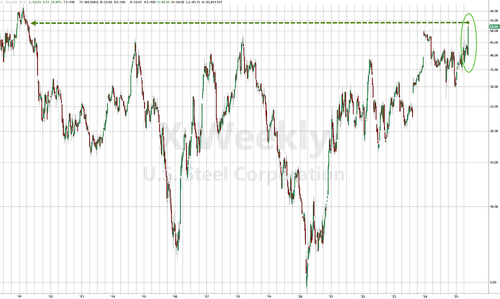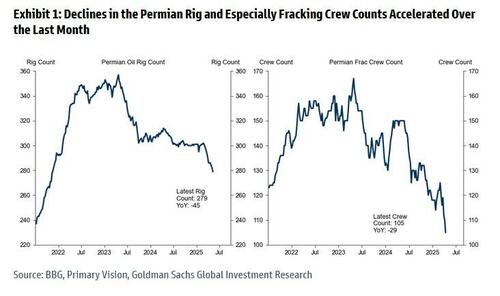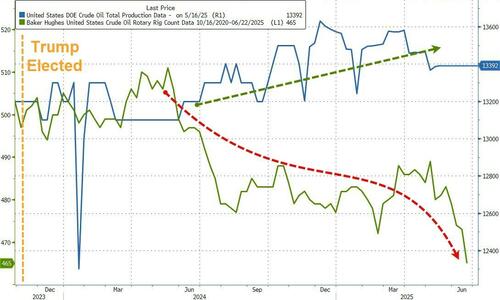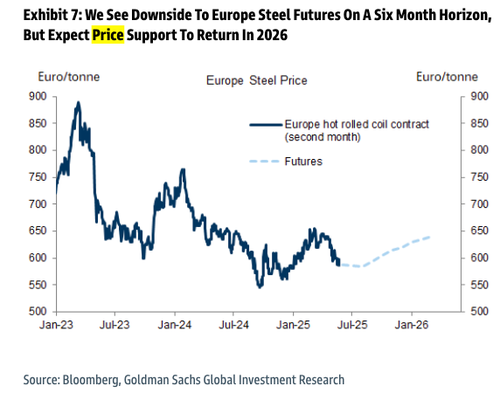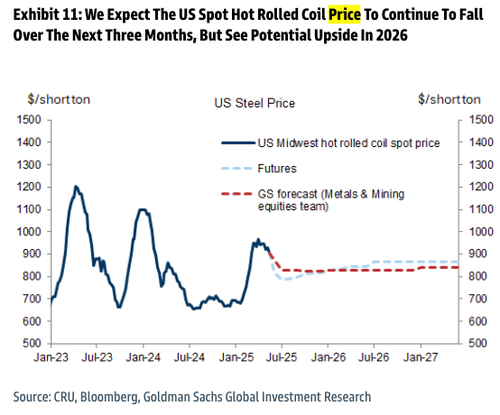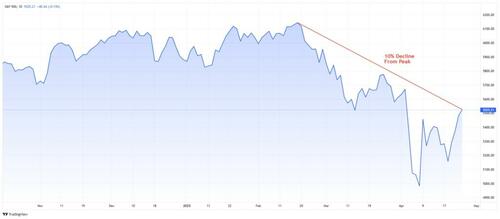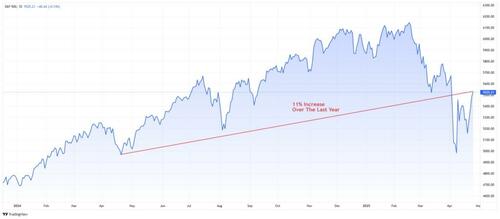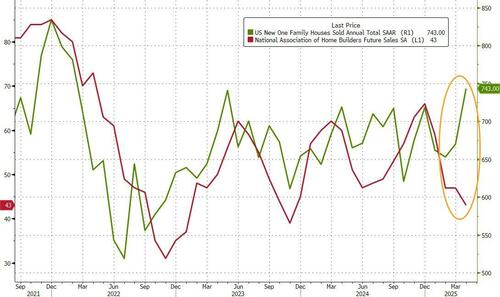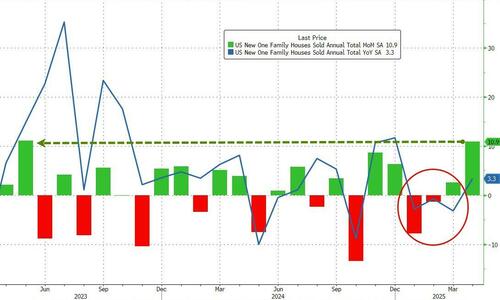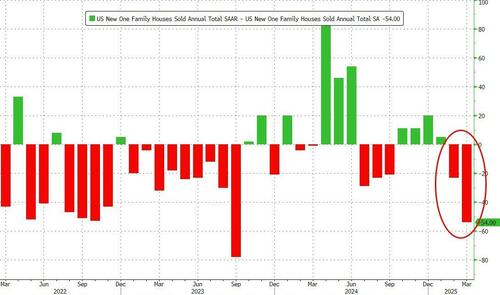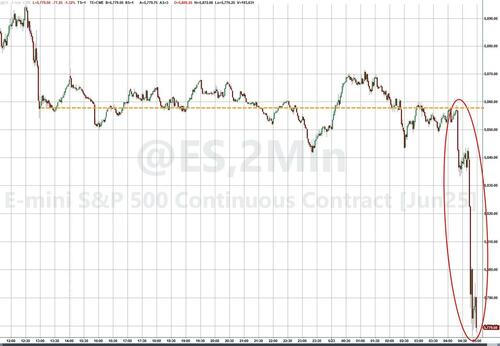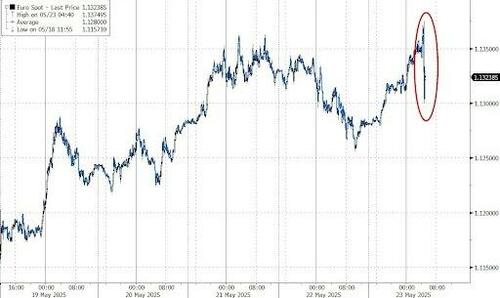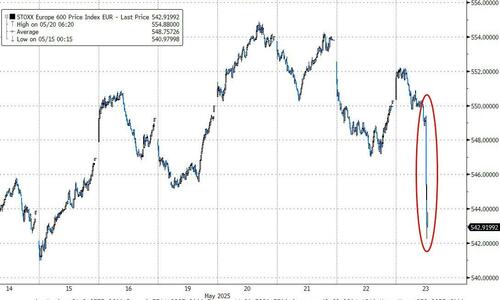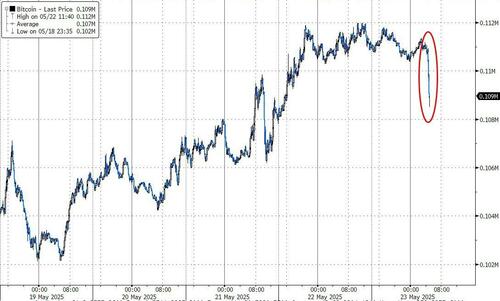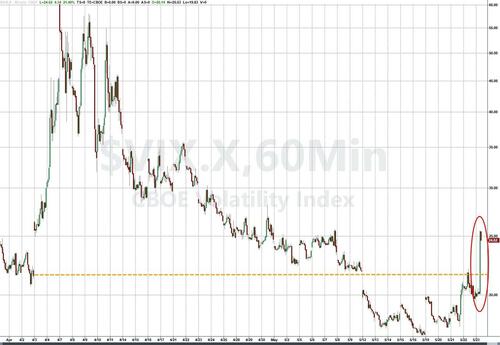“What is perfection in love? Love your enemies in such a way that you would desire to make them your brothers … For so did He love, Who hanging on the Cross, said ‘Father, forgive them, for they know not what they do.’” (Luke 23:34)
Distinction Matter - Subscribed Feeds
-
Site: Zero HedgeNetanyahu: Trump Told Me 'I Have Absolute Commitment To You'Tyler Durden Fri, 05/23/2025 - 17:00
Authored by Dave DeCamp via AntiWar.com,
Israeli Prime Minister Benjamin Netanyahu said at a press conference this week that President Trump had assured him that the US was committed to Israel despite a slew of media reports that have said there’s friction between the two leaders.
"Let me give you some details that perhaps haven’t been made public. A few days ago — I think around 10 days ago, maybe a little more — I spoke on the phone with President Trump," Netanyahu began, according to The Times of Israel.
 Via Reuters
Via Reuters
"And he said to me, literally: ‘Bibi, I want you to know — I have absolute commitment to you. I have absolute commitment to the State of Israel,'" the Israeli leader added.
Netanyahu said he also spoke with Vice President JD Vance. "[Vance] said to me… ‘Listen, don’t pay attention to all these fake news spins about this rupture between us… He said: It’s all spin.'"
"This isn’t the truth, you know it’s not true, and I’m telling you, from our side, it’s not true," the Israeli leader said.
Axios recently reported that Vance canceled a trip to Israel because he didn’t want it to appear that the Trump administration approved Israel’s major escalation in Gaza, although Vance denied the report and said he didn’t travel to Israel for "logistical" reasons.
"We’re coordinated with the [Trump] administration," Netanyahu said. “We speak with each other. We respect their interests, and they respect ours — and they overlap. I won’t tell you they align completely — obviously not — but they align almost completely."
The Trump administration has taken several steps in the region that appeared to go against Israel’s interests, including the ceasefire with Yemen’s Houthis and talks with Hamas. But there’s been no sign that the administration is willing to leverage military aid to force Netanyahu to end the genocidal war on Gaza, which continues to escalate.
Meanwhile, growing frustration on the American Right...
What if...
— Judge Napolitano (@Judgenap) May 22, 2025
Trump hosts Netanyahu at the WH to show him videos of the IDF slaughtering Palestinians, like he did the President of South Africa? pic.twitter.com/qfN5uspX9JNetanyahu also said on Wednesday that Israel wants to ensure “Trump’s plan” for Gaza is achieved, referring to the president’s calls for the permanent removal of the Palestinian population as part of a plan for the US to take over the territory. The Israeli leader has now listed the ethnic cleansing plan as a condition to end the war.
-
Site: LifeNews
Former staff of the recently shuttered Boulder Abortion Clinic announced plans to open a new facility in Boulder, Colorado, that would continue killing babies in abortions, including up to the moment of birth.
The move comes just weeks after the closure of the notorious abortion biz, which operated for 50 years and was linked to an estimated 42,000 abortions.
The Boulder Abortion Clinic, founded by Dr. Warren Hern in 1975, closed abruptly in April 2025, a development celebrated by pro-life groups as a victory for the unborn. Operation Rescue, a leading pro-life organization, noted its decades-long efforts to expose the abortion clinic’s practices, including documenting abortion-related injuries and a patient death.
However, the closure’s impact may be short-lived.
Click here to sign up for pro-life news alerts from LifeNews.com
Former staff, led by Alicia Moreno, the former chief operating officer, and Debbie Riccioli, its former director of counseling, have formed the RISE Collective—short for Reproductive Health, Inclusive Care, Support, and Empowerment—to establish a new late-term abortion facility in Boulder. The group, comprising nearly all of the abortion center’s former staff, plans to begin with late-term abortions and later expand to offer early trimester abortions.
“We have the most important part of the formula, which is a very well-trained staff,” Moreno told Boulder Reporting Lab, highlighting that 17 former employees, including 20% of the nation’s doctors trained in later abortions, are part of the effort.
The original Boulder Abortion Clinic faced decades of controversy, with pro-life groups labeling its closure a “victory” for protecting unborn children and their mothers. The abortion center was one of the few in the U.S. to kill babies after 28 weeks.
The RISE Collective’s plans have sparked particular concern due to Colorado’s lack of gestational limits on abortion, making it a destination for women seeking late-term abortions. Pro-life groups warn that the new clinic could continue to attract customers from across the country, perpetuating what they call a “culture of death.”
The former staff’s efforts to open the new abortion center have also raised questions about the abrupt closure of the original facility. Moreno and Riccioli told Boulder Reporting Lab they had spent two years planning a transition to take over the abortion biz, drafting a memorandum of understanding with Hern to formalize the handoff. However, Hern announced the closure on April 15, 2025, just one day after reportedly agreeing to the plan, leaving staff blindsided.
Pro-life advocates argue that the closure and the staff’s subsequent plans highlight the need for stronger protections for the unborn
As the RISE Collective works to secure a location and develop a business plan, pro-life groups are mobilizing to raise awareness and oppose the new abortion center’s opening.

The post Abortion Clinic Killings Babies in Abortions Up to Birth May Open in Colorado appeared first on LifeNews.com.
-
Site: LifeNews
Media coverage has been under a microscope recently, with various podcast hosts taking news reporters to task for their failures to report basic facts about former President Joe Biden. Did they not know the obvious?
That same level of scrutiny should extend to the coverage of the issue of abortion in which too often the obvious is not told. Far too often, news reports seem to treat the unborn child as if she is nothing. Not simply an inconvenience, but a nonentity.
When you take the baby out of the picture, the emphasis is placed on the circumstances of conception, rather than the humanity of the preborn child. This is a disservice not only to the baby but also to her mother. Because women who regret their abortions do not mourn “nothing.”
They mourn a human being, who might have greatly resembled themselves.
They mourn a person with a heartbeat.
They mourn a son or daughter, not a concept or a theory.
Click Like if you are pro-life to like the LifeNews Facebook page!
(function(d, s, id) { var js, fjs = d.getElementsByTagName(s)[0]; if (d.getElementById(id)) return; js = d.createElement(s); js.id = id; js.src = "//connect.facebook.net/en_US/sdk.js#xfbml=1&version=v2.10"; fjs.parentNode.insertBefore(js, fjs); }(document, 'script', 'facebook-jssdk'));
There needs to be vast improvements in the manner in which the media cover the issue of abortion. It is time for some soul-searching. Readers, listeners, and viewers deserve facts, not spin.
Telling the whole story means including the development of the unborn child, and the repercussions when that child is ripped from a mother’s womb or allowed to pass into a toilet. When a woman comes face-to-face with the aborted child, the trauma can be devastating.
Women deserve to know all of the facts before choosing abortion.
It’s high time for the media to give them the truth.
LifeNews.com Note: Maria Gallagher is the Legislative Director and Political Action Committee Director for the Pennsylvania Pro-Life Federation and she has written and reported for various broadcast and print media outlets, including National Public Radio, CBS Radio, and AP Radio.

The post Tell Women the Truth About Abortion: The Baby is a Human Being appeared first on LifeNews.com.
-
Site: Zero Hedge"The Greatest Ass-Covering Op In US History" Created The Democratic Party Of Hoaxes, Hustles, & HatredTyler Durden Fri, 05/23/2025 - 16:20
Authored by James Howard Kunstler,
Stumblebum's Legacy
"Every time I watch The View, I become even more misogynistic."
- Laura Loomer
Bad as it was, “Joe Biden,” the figment president was merely one manifestation of a nation made mad by power-seeking demons, real-live, ill-intentioned human beings driving a runaway political machine, the party of hoaxes, hustles, and hatred.
The country is just now struggling to exit a convulsion of mass mental illness. The demons are still there, though, and still hard at work trying to drag you all back into mass formation.
A central mystery is how the news media made itself the enemy of the people, and this conundrum is not at all explained by Jake Tapper and Alex Marshall in their book Original Sin.
It’s actually just another hustle with overtones of hoax, like everything else in the evil cavalcade of narratives spun out in the news media’s war on reality. Tapper and Marshall want you to believe that a faceless collective they call “the White House” managed to conceal “Joe Biden’s” well-advanced disintegration from the voting public, and that was. . . that. The media wuz fooled! Goll-lee!
Of course, that fails to explain a whole lot — such as: how come anybody watching daily video clips of “Joe Biden” in action, could not fail to see the broken old puppet he is. Alex Marshall, receiving his “award for excellence” from the White House Correspondents’ Association weeks ago said, “We just missed it.”
Yeah, sure...
They also apparently missed the programmatic devastation to American society that was carried out in the old stumblebum’s name.
I will give you the key to that conundrum, and then you will understand why all this happened, and why the many lingering demons are still at it in their self-styled “resistance” to America-in-recovery. Mr. Marshall lied, you understand. The media connived with the demons. They were in on the gag the whole time.
If there is any “original sin” in the story, it revolves around Hillary Clinton. This monster emerged as the junior partner to her husband, political wonder-boy Bill Clinton. From the get-go, the narrative painted her as a wife sore-beset by her charismatic husband’s infidelities. (Forget that her only child, Chelsea, is a dead-ringer for her former law partner, Webb Hubbell.) However their connubial affairs worked, Hill and Bill had a deal: when he was done, she would eventually rise to become the first woman president, and they would go down in history as two era-defining, Boomer gen, political wonder-geniuses.
It was a flawed plan.
For one thing, Hillary utterly lacked Bill’s political charisma, which was his ability to avidly engage with other people and their issues. Hillary didn’t care much for other people, and only pretended to be interested in their issues. Also, people could easily read that in her demeanor. Nobody was fooled. If anything, she had negative charm, anti-charisma. Her own interests were strictly limited to obtaining power and riches. With enough power, Hillary noticed, you didn’t need charm or charisma. You could simply order people around. But the power couple left the White House broke in 2001, and were caught trying to spirit away some of the presidential dinner-ware.
The next phase of Hillary’s career was fortune-building. The Clinton Foundation was set up in 1997, ostensibly to fund Bill’s presidential library. It would become a fantastic grift magnet in the years to come, taking them from broke-ass-broke to demi-billionaires. Her launching pad was a seat in the US Senate. (She ran and won in New York when she was still First Lady in the 2000 election.)
2008 was supposed to be Hillary’s apotheosis from senator to president. The setup was perfect. The country was tired of Double-ya Bush. The time was exactly right for a woman president. Hillary was the obvious choice by a country mile. Except that she was edged out in the primaries by the Democratic Party’s alternative play for something even more amazing, in a contest of historic firsts, than a woman president — a black president, proving to the world how morally upright the USA had become, America liked how it felt. We were good people, after all!
Barack Obama liked playing his role, and he seemed to have more charisma than Hillary (though he didn’t care much for other people either, really). His sketchy background included a lot of people tinged with Marxism, such as his mentor in Chicago, Bill Ayers, an infamous Sixties radical, rumored to have ghost-written Obama’s books. And he was ensorcelled by big bankers like Robert Rubin of CitiGroup, and by Globalist bigshots orbiting Davos and the WEF.
Yet, Senator Hillary Clinton was still aggregating power as leader of Democratic women voters, a massive base. It was clear that she would remain in the game, aiming for her eventual “turn” in the White House. So, Mr. Obama made a deal with her: he would elevate her to Secretary of State, further fortifying her credentials, and then stand behind her in a 2016 run.
Hillary used her years at State to also fortify the Clinton Foundation’s coffers in various pay-to-play schemes — such as the Skolkovo tech deal with Russia and the Uranium One deal that netted the Clinton Foundation combined pledges of over $275-million, according to Clinton Cash author Peter Schweizer. The 2010 Haiti earthquake crisis was another bonanza for the foundation and its partners. One might also surmise, from the recent DOGE reports, that the fabulous armature for grift that USAID became, spawning countless NGOs, was engineered by Obama appointees like Samantha Powers and Hillary’s State Department machine.
In 2015, Hillary, off-and-running, came to the rescue of the Democratic National Committee. The party was foundering in debt. It entered a joint fund-raising agreement with a PAC called Hillary for America (HFA) and the Hillary Victory Fund. The agreement gave Hillary control over the DNC’s finances, strategy, and staffing decisions that enabled her to snake out Senator Bernie Sanders for the nomination. Hillary’s nomination, the drive toward her “turn,” was when the trouble really blossomed.
Pitted against the rising outsider, Donald Trump, in 2016, Hillary’s lack of charisma was sinking her campaign. So, with a little help from John Brennan at the CIA, Glenn Simpson’s Fusion GPS political media company, the FBI under Director Jim Comey, and lawfare ninja Marc Elias at the Perkins Coie DC law firm, the Russia collusion hoax was dreamed up and put into action.
That was the “original sin” that set up the Party of hoaxes, hustles, and hatred to become greatest lie-spewing operation in US history, with reverberations for the decade-to-come. It also became the greatest ass-covering op in US history, with each successive raft of lies — the Mueller Investigation, impeachment #1, the stolen election of 2020 and installation of “Joe Biden,” the J-6 op, impeachment #2, the Trump prosecutions of 2024 — all requiring successive layers of cover-up and lies.
Since the news media despised Donald Trump, and was convinced by its own bullshit that Hillary would win the 2016 election, they all ran with the Russia collusion story and turned it into RussiaGate. They miscalculated, of course. Mr. Trump won, a stunning surprise, a shock really to everyone, including Mr. Trump himself, who utterly lacked experience running a government and was bamboozled, sand-bagged, and eventually hoaxed into defeat — Covid-19 being the coup-de-grace. The news media had to continue lying to the country throughout and beyond all of that to pretend that they were not equally culpable for all this mischief.
And so, they ran with every deception of “Joe Biden’s” ruinous term in office. Alas for them, the indefatigable Mr. Trump rallied, persevered through the concocted prosecutions cooked up by Norm Eisen, Mary McCord, Lisa Monaco, and the rest of lawfare ninjahood, and is now back in power with an assembled team of appointees who are the Left’s worst nightmare.
What kept it all going — all the lying, gaslighting, deception, prevarication, and sedition — was the lack of accountability. It was a fatal intoxicant. That’s over now, though turning in the direction of justice is necessarily difficult and delicate, considering the elevated level of derangement among the public, the fragility of the national psyche, and the danger signals emanating from the zeitgeist.
It looks like the accounting will begin in earnest now. We are going to find out who was acting behind the empty figure of “Joe Biden,” and who ran the auto-pen. And working backward from there, this will all unspool in one, long, appalling thread of treason.
-
Site: LifeNews
Liberals have a new argument for keeping federal money flowing to Planned Parenthood: defunding the organization would cost taxpayers more.
Democrats and abortion advocates are framing the defunding of one of the largest abortion providers in the country as a financial “cost” to taxpaying Americans. Citing estimates from the Congressional Budget Office (CBO), they are voicing concern that the GOP’s plan to block Medicaid funding for Planned Parenthood through the GOP reconciliation bill would increase the national deficit by $300 million due to more babies being born.
“About three in four people say they oppose defunding Planned Parenthood health centers. But Republicans do not care — they need to appease their far-right, anti-choice fringe,” Democratic Washington Sen. Patty Murray said on May 14 about the CBO’s estimates. “Although the irony is, in this case, defunding Planned Parenthood would actually cost our country more money in the long term.”
HELP LIFENEWS SAVE BABIES FROM ABORTION! Please help LifeNews.com with a donation!
Murray’s office did not respond to the Daily Caller News Foundation’s request for comment.
Planned Parenthood performed over 400,000 abortions in fiscal year 2023-24 and received more than $700 million in government reimbursements and grants, according to its latest annual report. In contrast, private contributions dropped 31% relative to the previous fiscal year, totaling $684.1 million.
The CBO declined to clarify how the deficit would increase due to the federal cuts in response to a DCNF inquiry.
However, the CBO stated in 2015 that a House bill to block federal funding to Planned Parenthood would increase spending by $130 million over the course of a decade. The reason, CBO explained, was that the bill would reduce “services that help women avert pregnancies” and that “additional births that would result from enacting such a bill would add to federal spending for Medicaid.”
“Nearly 200 Planned Parenthood health centers could be forced to shutter, and more than 1.1 million patients could lose access to care. Cancers will go undetected, STIs will go untreated, and birth control will be harder to get,” said Planned Parenthood CEO Alexis McGill Johnson in a statement on the House’s Thursday vote to advance the reconciliation bill. She equated the CBO’s estimates of the deficit impact to “charging the taxpayers nearly $300 million.”
On the other side of the issue, pro-life advocates reject the premise of the estimates.
“While the Congressional Budget Office has yet to provide a full breakdown of its estimate, it appears the analysis includes the costs of supporting children born due to this provision but falls short and overlooks the long-term economic contributions these individuals will make — as workers, taxpayers and contributors to Social Security — in adulthood. Not to mention the benefit each person brings as a valued member of their family, their community and this country,” Emily Erin Davis, vice president of communications for Susan B. Anthony Pro-Life America, told the DCNF. “It’s especially surprising to see Democrats raise cost as a concern, given their longstanding record of opposing efforts to reduce federal spending.”
Some fiscal hawks in the GOP are also skeptical about the CBO estimate. Republican South Carolina Rep. Ralph Norman recently told NOTUS he “doesn’t believe” the agency’s projection, while Republican Texas Rep. Chip Roy said the deficit should be reduced in other ways.
Whether the provision in the GOP megabill survives the Senate remains uncertain, as some moderate Republicans have expressed reservations. For instance, Sen. Lisa Murkowski of Alaska recently told NOTUS she will “continue to be an advocate for the services that Planned Parenthood provides.”
Early this month, 183 pro-life state legislators from across the country sent a letter urging congressional GOP leadership to include the provision in the final reconciliation package.
LifeNews Note: Melissa O’Rourke writes for Daily Caller. Content created by The Daily Caller News Foundation is available without charge to any eligible news publisher that can provide a large audience.

The post Democrats Oppose Defunding Planned Parenthood Because More Babies Will be Born appeared first on LifeNews.com.
-
Site: Zero HedgeTrump Endorses U.S. Steel-Nippon DealTyler Durden Fri, 05/23/2025 - 16:00
United States Steel Corp. shares surged to their highest level since April 2011 after President Trump announced on Truth Social his full backing of a partnership between the Pittsburgh-based steelmaker and Japan's Nippon Steel.
Trump confirmed that U.S. Steel will remain headquartered in Pittsburgh, calling the deal the largest investment in Pennsylvania's history and a first critical step in revitalizing the nation's steel industry, aligning with his 'America First' agenda of rebuilding critical supply chains.
"I am proud to announce that, after much consideration and negotiation, US Steel will REMAIN in America, and keep its Headquarters in the Great City of Pittsburgh," Trump wrote on Truth Social.
He continued, "For many years, the name, "United States Steel" was synonymous with Greatness, and now, it will be again. This will be a planned partnership between United States Steel and Nippon Steel, which will create at least 70,000 jobs, and add $14 Billion Dollars to the U.S. Economy."
The president said much of the investment will unfold over the next 14 months and will be "the largest Investment in the History of the Commonwealth of Pennsylvania."
Trump concluded the post by stating: "My tariff policies will ensure that steel will once again be, forever, MADE IN AMERICA. From Pennsylvania to Arkansas, and from Minnesota to Indiana, AMERICAN MADE is BACK. I will see you all at U.S. Steel in Pittsburgh on Friday, May 30, for a BIG rally."
Earlier, a Wall Street Journal report said that Nippon sweetened the deal by "roughly doubling its spending plan and even pledging to build a brand-new mill to win Washington's blessing for its takeover of U.S. Steel."
While Trump initially criticized the deal, he has since warmed to it because it aligns with America First's policy goals of bolstering domestic supply chains and revitalizing manufacturing.
The merger agreement between U.S. Steel and Nippon, which values U.S. Steel at $55 per share, expires June 18 unless extended.
Shares of U.S. Steel jumped to the highest level since April 2011 following the president's Truth Social post.
Meanwhile, the United Steelworkers union remains strongly opposed, citing Nippon's history of undercutting U.S. steel markets.
-
Site: Zero HedgeFather Of DC Shooting Suspect Was Democrats' Honored Guest At Trump Congressional AddressTyler Durden Fri, 05/23/2025 - 15:40
Authored by Debra Heine via American Greatness,
The father of the suspected gunman in the murder of two Israeli Embassy staffers at the Capital Jewish Museum on Wednesday, was the honored guest of a far-left lawmaker at President Trump’s joint address to Congress back in March, the New York Post reported.
Eric Rodriguez is an anti-Trump SEIU member who also spoke at a Democrat press conference ahead of Trump’s address.
His son, accused killer Elias Rodriguez, 30, has been charged with two counts of first-degree murder after allegedly gunning down Yaron Lischinsky, 28, and Sarah Milgrim, 26, who were about to become engaged.
“Eric Rodriguez was our guest during the President’s Joint Speech to Congress, but we don’t know his family,” a spokesperson for Rep. Jesús “Chuy” García (D-Ill.) told the Post Thursday night.
García in March had described Rodriguez as “an outspoken advocate against attacks on veterans’ services and the rights of unionized federal employees.”
His mention of “attacks on veteran services” appeared to be a reference to the Department of Government Efficiency’s work eliminating of waste fraud and abuse from the system.
“Eric represents the very best of our community — someone who has served his country, continues to serve his fellow veterans and fights every day to protect the dignity of working people,” the congressman said in a statement on March 3. “His presence at the Joint Address is a powerful statement: we will not sit back while veterans and workers are treated as political pawns.”
According to the Post, Rodriguez also appeared in a Service Employees International Union (SEIU) video that same day, speaking as an Iraq War vet and an employee with the Veterans Affairs Department.
The SEIU, one of the largest labor unions in North America, donates millions of dollars to left-wing Democrat politicians who promote government expansion and higher taxes.
“I’ve been with the VA for three years, and the reason why I’m in Washington, DC, is because I’m concerned about what Donald Trump, Elon Musk and DOGE are doing to the VA system,” he said in the SEIU video.
Rodriguez was also a featured speaker at an emotional Democrat press conference on March 4.
Flanked by Rep. Ted Lieu (D-Calif.), House minority leader Hakeem Jeffries (D-N.Y.) and other Democrat lawmakers, Rodriguez appeared on the verge of tears as he decried the DOGE cuts.
“Right now the Trump administration is trying to cut the VA, frontline workers, and let billionaires steal our healthcare. Veterans, we’re under attack. Last week, 1,400 workers got fired illegally,” he said.
“They’re slashing staff, crushing unions, and selling out the VA—for what? So billionaires can make more money while Veterans sit on a waitlist. Or worse, get no treatment,” Rodriguez added.
That video was shared on social media by the left-wing veterans group “VoteVets.”
His son Elias on Wednesday unleashed nearly two dozen rounds on the young Jewish couple, and shouted “Free, free Palestine” when he was taken into custody.
[ZH: And while we're down the rabbit hole - CIA contractor and big data expert Tony Seruga says GPS puts the elder Rodriguez at Barack Obama's Washington DC residence for 32 minutes back in March]
GPS—put the Israeli capital Jewish Museum shooter’s father at Barack Hussein Obama II’s Washington, D.C. residence (which is a quick 4 minute walk from The Islamic Center of Washington D.C..) back in March for 32 minutes.
— Tony Seruga (@TonySeruga) May 23, 2025
And now we find out Democrats invited accused terrorist… pic.twitter.com/H1DKcOQkCC* * *
Rep. García condemned the murders in a statement posted on social media Thursday.
“I strongly condemn this horrible, senseless act of antisemitism. My heart is with the victims and everyone impacted by the attack,” García posted on X. “We mourn the lives lost and reject the idea that justice can be won through violence.”
And now we find out Democrats invited accused terrorist (Elias) killer's DAD (Eric Rodriguez) to Trump address just weeks before heinous crime pic.twitter.com/dgGQ6ZX5Af
— Joni Job (@jj_talking) May 23, 2025* * *
Check out this lighter / flashlight combo...
 Satisfaction guaranteed or your money back
Satisfaction guaranteed or your money back
-
Site: Zero HedgeOracle To Splurge $40 Billion On Nvidia Chips For Mega AI Data Center In TexasTyler Durden Fri, 05/23/2025 - 15:25
As the U.S. heads into Memorial Day weekend, with pools opening, millions set to travel, and backyard barbecues just ahead, a late-session report from the Financial Times revealed that one of President Trump's first Project Stargate AI infrastructure projects is underway in Texas.
According to FT's sources, the under-construction AI data center in Abilene, Texas, is the first U.S. Stargate project, and Oracle is purchasing a staggering 400,000 Nvidia GB200 "Superchips" that will be housed in eight buildings. When the facility comes online next year, the AI chips will require a massive 1.2 gigawatts of electricity.
Site owners Crusoe and Blue Owl Capital have raised $15 billion in debt and equity to finance the Abilene project. JPMorgan provided a sizeable chunk of the debt financing, totaling $9.6 billion across two loans, with $7.1 billion announced this week, according to people familiar with the matter.
Crusoe and Blue Owl have separately invested about $5 billion in cash. Oracle has signed a 15-year lease for the mega project that will be fully operational by mid-2026.
Your hard hat tour of OpenAI’s Stargate megafactory in Abilene, TX with @sama @ChaseLochmiller and lots of red dirt
— Emily Chang (@emilychangtv) May 20, 2025
pic.twitter.com/mMkeKpLVOUThe Abilene facility is part of the broader Stargate project, a $500 billion effort to scale U.S. AI computing backed by OpenAI, SoftBank, Oracle, and Abu Dhabi's MGX. The new Abilene data center will rival Elon Musk's plans to expand his "Colossus" data center in Memphis, Tennessee.
"The Abilene data center is a crucial step in OpenAI's move to reduce its dependence on Microsoft," FT noted, adding, "OpenAI and Microsoft agreed to terminate their exclusivity agreement earlier this year after the startup became frustrated that its demand for power far exceeded the US tech giant's supply."
Sources said Oracle will be leasing the computer power of the 400,000 Nvidia GB200 chips to chatbot startup OpenAI.
Meanwhile, massive U.S. data centers continue to come online—even as China's DeepSeek AI has demonstrated high efficiency, delivering more useful computation with less power. This raises a critical question: Have U.S. AI projects achieved similar levels of efficiency, or are they falling behind in the AI race? Remember what Goldman said about the data center peak capacity in April? Well...
-
Site: LifeNews
The Texas House of Representatives passed the Stop Tax-Funded Abortion Travel Act (Senate Bill 33) on Thursday with an 87-58 vote. The measure will block local governments from sending tax dollars to organizations that pay for out-of-state abortion costs, like flights and hotels. Now, the policy will head to the Senate for final approval and then be signed into law by the governor.
Texas Right to Life brought the Stop Tax-Funded Abortion Travel Act to lawmakers after the San Antonio and Austin city councils dedicated half a million dollars to abortion groups. Austin, specifically, handed $100,000 in taxpayer funds to an organization that sends teens to other states for free abortions—with or without their parents’ knowledge.
Click Like if you are pro-life to like the LifeNews Facebook page!
(function(d, s, id) { var js, fjs = d.getElementsByTagName(s)[0]; if (d.getElementById(id)) return; js = d.createElement(s); js.id = id; js.src = "//connect.facebook.net/en_US/sdk.js#xfbml=1&version=v2.10"; fjs.parentNode.insertBefore(js, fjs); }(document, 'script', 'facebook-jssdk'));
Governments should not pay to kill their youngest citizens, and taxpayers should not be forced to participate in this violence.
On the same day, the Texas House also passed the Life of the Mother Act (Senate Bill 31). The measure will prevent delays in medical care and equip doctors and lawyers with accurate knowledge of the state’s Pro-Life laws. Despite claims from Democrats and the media, Pro-Life protections and emergency care work in harmony. If a mother faces pregnancy complications, there are several ways doctors can work to save both lives rather than abort the baby. However, if a procedure must be done that costs the life of the child, it can only be in cases where the mother’s condition would be life-threatening, according to Senate Bill 31 and previous standards.
Texas must value and protect mothers and babies together. Thursday’s victory with the Stop Tax-Funded Abortion Travel Act will save lives from out-of-state abortions, but thousands more children are still at risk. Every year, 19,000 abortion pills are ordered online and delivered to Texas in the mail, the abortion industry’s new method to skirt current laws. These drugs not only kill preborn babies but send one in 10 women who consume them to an emergency room. In the final days of Texas’ 2025 legislative session, lawmakers must pass the Woman and Child Protection Act (Senate Bill 2880) to stop the abortion industry’s underground network.

The post Texas House Passes Ban on Taxpayer-Funded Abortion Travel appeared first on LifeNews.com.
-
Site: Zero HedgeHere Are 6 Signs That The Housing Market Depression In The US Is Getting Even WorseTyler Durden Fri, 05/23/2025 - 15:05
Authored by Michael Snyder via The Economic Collapse blog,
America’s housing market has been in a “deep freeze” for more than a year.
The combination of very high interest rates and very high home prices has frozen millions of potential buyers out of the market. As a result, home sales have fallen to extremely depressed levels. When I first warned that we were heading into a housing market depression, a lot of people thought that I was exaggerating. But now the numbers show that is exactly what has happened.
The following are 6 signs that the housing market depression in the United States is getting even worse.
#1 Sales of previously-owned homes in the U.S. just fell again. In fact, we just witnessed the slowest April that we have seen since 2009…
The spring housing market continues to struggle amid high interest rates and low consumer confidence.
Sales of previously owned homes in April declined 0.5% from March to a seasonally adjusted, annualized rate of 4 million units, according to the National Association of Realtors. That is the slowest April pace since 2009.
In 2009, there were 306 million people living in the United States.
Today, there are 340 million people living in the United States.
So the fact that we have fallen to a level that we haven’t seen since the Great Recession should deeply trouble all of us.
#2 Sales of previously-owned homes are falling even though active listings and new listings are both rising…
Active listings—the total number of homes for sale—last month hit the highest level since March 2020. They climbed 1.2% from a month earlier on a seasonally adjusted basis and rose 16.7% year over year.
New listings rose to the highest level since July 2022, increasing 1.3% month over month on a seasonally adjusted basis and 8.6% year over year—the largest annual gain since May 2024.
“A lot of people are selling their homes and downsizing because they’re worried about the economy,” said Meme Loggins, a Redfin Premier real estate agent in Portland, OR. “During the pandemic, everybody wanted more space for a home office or for their kids to run around, but now people are more focused on saving money. A lot of folks are getting rid of their investment properties, and I’m working with a couple of federal employees who are afraid of losing their jobs, so they’re selling their homes and thinking of moving into condos.”
#3 Most potential young homebuyers have been completely forced out of the market. Shockingly, the average age of a homebuyer in the U.S. has surged to an all-time record high of 56…
The average age of homebuyers in the U.S. has risen by six years since July 2023 — another sign that younger Americans are being priced out of the market due to escalating ownership costs.
The average age of homebuyers is now 56, up from 49 in 2023, according to the National Association of Realtors’ annual state-of-the-market report released Monday. That’s a historic high, up from an average age in the low-to-mid 40s in the early 2010s.
#4 The median age of first-time homebuyers is spiking as well…
The median age of first-time buyers also rose from 35 to 38, while the share of first-timers dropped from 32% to 24% of all buyers for the year ending July 2024. That marks the lowest percentage since NAR started tracking the metric in 1981.
“In my two decades in the mortgage business, I’ve never seen a more difficult time for millennials to purchase a home,” says Bob Driscoll, senior vice president and director of residential lending at Massachusetts-based bank Rockland Trust.
This is a really bad thing for our society.
If most young couples cannot purchase a home until they are in their late thirties, something has gone horribly, horribly wrong.
#5 Zillow is reporting that home values have fallen in 27 U.S. states so far this year. Is this the beginning of a price crash?…
Home values fell in half the country as the housing market faces a nationwide downturn.
According to Zillow, monthly home values dropped in 27 out of the 50 states this year. While Florida, Colorado, Washington, D.C., California and Washington state experienced the greatest value declines from March to April, the data could foreshadow a larger housing market shift.
#6 Meanwhile, employers continue to conduct mass layoffs all over the nation, and this is only going to increase pressure on the housing market. For example, Walmart just announced that it will be laying off about 1,500 very well paid corporate employees…
Walmart is laying off around 1,500 corporate employees across various departments within its home office in Bentonville, Arkansas, multiple reports say.
In a memo shared with associates on May 21, Walmart executives said the company is “reshaping” some of its teams in an effort to modernize its business and enhance “associate, customer and member experiences.”
Most of the U.S. population simply cannot afford to shell out several thousand dollars for a mortgage payment every month.
Either interest rates will have to come down or housing prices will.
And if housing prices start falling like we saw in 2008 and 2009, that will cause all sorts of problems for our major financial institutions.
So hopefully the Federal Reserve will cut interest rates before it is too late.
One recent survey discovered that financial stress is at an all-time high for 70 percent of the U.S. population.
Absurdly high housing costs are one of the biggest reasons why so many people are financially stressed right now.
Home prices are way too high and so are rental prices.
If you were able to purchase a home and lock in a mortgage more than five years ago, you were extremely fortunate.
Those that wish to relocate now are facing ridiculously high prices and painfully high interest rates.
It has been said that he who hesitates is lost.
In this case, that is so true.
A lot of people out there that waited to pull the trigger have completely missed their chance.
Now the housing market is entering a very difficult chapter, and a tremendous amount of pain is ahead.
* * *
Michael’s new book entitled “10 Prophetic Events That Are Coming Next” is available in paperback and for the Kindle on Amazon.com, and you can subscribe to his Substack newsletter at michaeltsnyder.substack.com.
-
Site: AsiaNews.itOn Tuesday the company informed its employees via WhatsApp, shocking workers and unions. A worker told AsiaNews that, 'compensation will help us for a few days, but what about after that' The Ministry of Labour was not informed until the last moment. The 'Company has threatened workers against requesting an inquiry,' reports the Dabindu Collective.
-
Site: LifeNews
On a quiet Saturday morning in Palm Springs, California, Guy Edward Bartkus drove to a fertility clinic, detonated a car bomb, and blew himself apart—injuring four others and aiming to destroy not only a building, but thousands of innocent lives.
Bartkus wasn’t just a disturbed loner. He was a radicalized pro-mortalist and anti-natalist—someone who hated babies, despised human reproduction, and believed the world would be better if humanity ceased to exist. In his twisted view, even frozen embryos—children in their earliest stages—were so repugnant, he sought to wipe them out in a single blast.
This wasn’t a clinic bombing. It was an attempted mass murder of thousands of preborn children—a vile act that, if successful, could have eclipsed 9/11 in death toll, without a bullet fired or a plane hijacked.
Click Like if you are pro-life to like the LifeNews Facebook page!
(function(d, s, id) { var js, fjs = d.getElementsByTagName(s)[0]; if (d.getElementById(id)) return; js = d.createElement(s); js.id = id; js.src = "//connect.facebook.net/en_US/sdk.js#xfbml=1&version=v2.10"; fjs.parentNode.insertBefore(js, fjs); }(document, 'script', 'facebook-jssdk'));
This brutal act by an angry, broken, and murderous young man is the natural progression of a shamelessly promoted anti-god, anti-life ideology.
It’s the true face of the modern left: the Democrat Party, radical environmentalists, global depopulation zealots, and abortion industry profiteers. From abortion-on-demand to anti-natalist propaganda, they preach the same godless gospel: “Human life is the problem—kill it!”
These monsters preach and act on that philosophy—hence the attempted assassinations of Rep. Steve Scalise, President Donald Trump, and even myself, as I have received death threats simply for defending life.
This ghastly philosophy is akin to Hitler, Stalin, Mao, and the Chinese Communist Party—ideologues who saw people as disposable, and who sacrificed millions on the altar of control, or eugenics. Cecile Richards and Margaret Sanger would be proud.
Thankfully, however, the world is not governed by the likes of these insane pro-mortalists, not yet anyway. Thankfully, the unchangeable moral ethic established on Mount Sinai continues to prevail. Human life is not a virus to be eradicated. It is the highest expression of divine beauty. Each person is made in the image of God, imbued with eternal worth, and offered redemption through the life, death and resurrection of Jesus Christ.
Bartkus’s bombing was demonic, yes—but it was also the logical conclusion of a world that embraces abortion, glorifies suicide, and calls child-killing “progress.” Anyone who gives themself to that type of darkness can become another Bartkus.
At Operation Rescue, we exist to shine a light into that darkness—to expose the killers in lab coats, the lawmakers who protect them, and the philosophies that fuel their culture of death. To engage the culture of death with the light of Christ.
And we will not back down. We will not be silent. To those who traffic in death, your reign of terror cannot last, because the God of Life cannot be mocked. Life and Light will always prevail.
LifeNews Note: Troy Newman is the president of Operation Rescue.

The post Radical Abortion Activist Hated Babies So Much He Blew Up a Fertility Clinic appeared first on LifeNews.com.
-
Site: Fr. Z's BlogI bring to your attention something I found which was uplifting: An American tale with an American pope It’ll take just a few seconds to read. Next, Jesuits (who else) pray to … wait for it… the demon “Pachamama”. HERE … Read More →
-
Site: Zero HedgeOil War Makes Landfall: Permian Rigs, Crew Counts Crater As Oil Prices Plunge, And It's About To Get Much Worse...Tyler Durden Fri, 05/23/2025 - 14:45
Two weeks after Travis Stice, CEO of shale giant Diamondback Energy, warned that the US energy industry "is at a tipping point" and - more ominously - that US shale output has finally peaked (resulting in Diamondback slashing its capex budget as Saudi Arabia launched the latest OPEC+ price war), we now have confirmation that the CEO was right.
As Goldman commodity strategist Yulia Grigsby writes in her latest Oil Tracker note, amid continued declines in oil prices, there was a silver lining: namely that US total rig and frac spread count continued to decline quickly, especially in the Permian, -14% and -22% from year ago, respectively, as shown in the chart below.
Grigsby speculates that while the Permian activity slowdown may partly reflect the preservation of the best inventory rather than wells shutdowns, oil fields with higher breakevens, e.g. North Dakota shale, are also planning to reduce drilling activity.
And, having previously taken stock of Q1 earnings reports, we remind readers that several high profile public producers already reduced their drilling and completion activity on the back of lower prices and most producers reduced their 2025 capex guidance. As a result, Goldman expects the crude production in the US Lower 48 to decline by 0.4mb/d by 2026Q4 from 2024Q4.
Incidentally the latest Baker Hughes data showed that rotary rigs in the US tumbled by another 8 in the latest week...
...and are now down to a 4 year low of 465 as the industry enters crisis "cash conservation" mode.
But one doesn't have to believe in "peak oil" to expect further US production declines: regulation and sharply higher extraction prices may suffice to send the price of oil surging.
According to Bloomberg, Texas regulators are warning that wastewater from fracking in the biggest US oil basin is causing a "widespread" increase in underground pressure — a development that risks hindering crude output and harming the environment.
Shale oil wells in the Permian Basin generate millions of gallons of chemical-laced water, which drillers then pump back into the earth. Landowners and activists have said for years that this process causes toxic leaks. Now the state’s powerful oil and gas regulator, the Railroad Commission of Texas, is acknowledging the scale of the problem and imposing restrictions that could increase crude production costs.
Chevron Corp., BP Plc, and Coterra Energy Inc. as well as water management specialists Waterbridge Operating LLC and NGL Energy Partners, are among the companies that have received notices about the pressure issue from the Railroad Commission of Texas, according to a Bloomberg News review of public records. The RRC sent the messages to companies applying for new wastewater disposal wells.
Producers began injecting more water into shallow rock formations roughly five years ago after pumping it deep below the surface was found to trigger earthquakes. But the volumes are now so large that the dirty water is breaching wells and causing the ground to swell and rupture, threatening to contaminate drinking supplies for people and livestock.
Potential restrictions on both deep and shallow injection zones could mean producers will have to pump their wastewater farther afield, increase recycling or pay to clean it up. All of these options would add to costs in the Permian, which accounts for about half of America's total crude production. It would be the latest blow to US producers already grappling with low oil prices and a shrinking inventory of top-tier drilling sites, despite President Donald Trump’s pledge to unleash US “energy dominance” by backing fossil fuels.
According to Bloomberg, the RRC has updated its standard language in the letters to producers in a nod to the severity of the problem. It now says that disposing wastewater into the Delaware Mountain Group rock formation in the prolific western part of the Permian “has resulted in widespread increases in reservoir pressure that may not be in the public interest and may harm mineral and freshwater resources in Texas.”
“Drilling hazards, hydrocarbon production losses, uncontrolled flows, ground surface deformation, and seismic activity have been observed,” the commission says.
Guaranteeing that US oil output will slide, starting next month, the RRC will place limits on water-pressure levels due to “the physical limitations of the disposal reservoirs.” It will also require operators to assess old or unplugged oil wells within half a mile of the disposal site, twice the previous distance.
The RRC’s staff has been studying issues related to wastewater disposal for several years, spokesperson Bryce Dubee said in an email.
“Let there be no doubt that our work and analysis to protect residents and the environment in West Texas has been happening for years and will continue,” Dubee said. The commission conducted a two-hour webinar on Thursday to explain its new guidelines for permitting saltwater disposal wells in the Permian.
Permian Basin oil production has soared over the past decade to about 6.7 million barrels of oil each day, more than the output from Iraq and Kuwait combined, and in some views has become a global swing producer. But for each barrel of crude, it produces three to five barrels of water that contain so much salt and toxic materials that pumping it back underground is the only cost-effective disposal method.
The shallow disposal zones, located between oil-rich layers of shale and the surface, consist of porous rock that can absorb water. But the 100-year history of crude production in the Permian means they are perforated with thousands of well bores, some up to a mile deep. Because of higher water pressure, fluids are now breaking through to oil drilling areas and old wells that were either abandoned or poorly cemented shut decades ago.
The regulator’s tighter restrictions come just weeks after Coterra was forced to halt some oil production in Culberson County, Texas, after waste fluids leaked into its wells. Executives said the problem was localized and could be fixed by strengthening the protective casing around its wells.
Coterra is remediating the affected wells but did not give an expected completion date. The company said it doesn’t expect the issue to affect its long-term reserves.
“We thought we were well calibrated,” Blake Sirgo, Coterra’s senior vice president for operations, said on a call with analysts May 6. “Sometimes the oil field still surprises us.”
One person who’s not surprised is Sarah Stogner, the district attorney for three West Texas counties in the Permian Basin. She’s been warning of rising subsurface pressure since 2021, when a landowner noticed oil and gas oozing from old wells on her property that had sat idle for decades. Stogner, then a lawyer for the landowner, publicized the case on social media, calling them “zombie wells.” Over the next few years, several more wells blew out in the area, with some ejecting toxic fluids more than 100 feet in the air for several days.
“These were old fields that suffered from a lack of pressure for decades,” she said. “Suddenly we were seeing pressure where it shouldn’t be. It was clear even back then there was a field-wide problem.”
The RRC mostly ignored her appeals for a thorough investigation, she said. Its elected commissioners, whose campaigns are largely funded by the oil and gas industry, framed the issue as primarily a plugging problem, claiming that old and abandoned wells had been improperly cemented shut, or not at all.
But it’s now becoming clearer that the underlying problem is too much wastewater injection.
One blowout near Imperial, Texas, gushed toxic water high in the air for two weeks and had to be cemented shut in 2022. Researchers at Southern Methodist University later found the ground around the eruption site had been steadily bulging for three years, eventually rising 40 centimeters (16 inches) before it burst open. Wastewater injection volumes several kilometers away “strongly correlate” with the ground movement, they said in a paper published in July 2024.
SkyGeo, an analytics company that uses radar to track ground movements, reached a similar conclusion.
“The injection of saltwater causes this unnaturally high pressure, and then it’s going to find weak spots to come out,” said CEO Pieter Bas Leezenberg.
The RRC said its new permitting requirements will “ensure injected fluids remain confined to the disposal formations to safeguard ground and surface fresh water.” To Stogner, the measures are an admission that toxic water leaks are a serious problem for the regulator, and for the Permian Basin. “They just completely ignored us,” she said. “But now they cannot deny that it’s happening.”
And with that, oil producers will no longer be able to sweep the toxic problem under the rug - or ground as it may be - and since the mandated changes will require millions if not billions in additional spending to comply with regulations, which means all-in production costs are set to soar, and since oil prices will only continue to slide, we are about to see a wholesale shutdown of the Permian, and - as because the commodity cycle never fail - all the excess production in the US will turn into a deficit, sending oil prices soaring as the commodity bullwhip effect comes home.
-
Site: AsiaNews.itThe young woman, killed in Washington with her colleague and boyfriend Yaron Lischinsky, by an attacker who shouted "I did it for Gaza, I did it for Palestine', was actively involved with an NGO that brings together Israelis and Palestinians to build common ground and coexistence using new technologies. Unlike the extremists who fan the flames, the group sees 'people behind the propaganda'.
-
Site: Zero HedgeLargest POW Swap Of Ukraine War Unfolds - 2K Total In Coming DaysTyler Durden Fri, 05/23/2025 - 13:25
Last week's Istanbul peace talks between Russia and Ukraine did not lead to much in terms of achieving ceasefire or peace as there were no breakthroughs whatsoever. However, it did give the two sides a chance to increase their swaps of POWs, and this is where Istanbul bore fruit.
The delegations agreed to a swap of 1,000 captives from each side, totaling 2,000 - which makes it by far the biggest single exchange of the war. Friday saw the two sides complete an initial round of fulfilling this agreement, with almost 800 people released.
 Image source: Zelenskyy/Telegram
Image source: Zelenskyy/Telegram
The Russian Ministry of Defense said in a statement that "270 Russian servicemen and 120 civilians" were returned to Russia on Friday, wile Ukraine said 390 people arrived back to Ukraine, including 270 military personnel and 120 civilians. Three women were among the Ukrainians released.
"We are bringing our people home," Ukraine’s President Volodymyr Zelensky declared on social media. The swap happened at the Belarus-Ukraine border, and was facilitated by several buses.
Zelensky confirmed: "The first part of the agreement to exchange 1000 for 1000 has been implemented."
"On the Ukrainian side, dozens of people waited for hours to greet the returnees at a meeting place in Chernihiv region in northern Ukraine, many hoping to see their family members among those being brought back," observed one report.
"Many brought Ukrainian flags and photographs of their loved ones – in case any of the returnees would recognize them and give them information about their whereabouts," the report added.
The NY Times alleges that Ukrainian prisoners in Russian hands are treated much worse:
Unlike Moscow, Kyiv is also sensitive to demands by the Western nations backing its military that Ukraine comply with international law on the treatment of prisoners.
The Ukrainians allow visits to prisoner of war camps by both the United Nations and Red Cross; those organizations have largely been denied access in Russia and the Ukrainian territory it occupies.
Russia and Ukraine have begun a large exchange of prisoners of war on Friday, the Russian Defense Ministry said, with around 1,000 soldiers from each side expected to be swapped at the Ukraine-Belarus border when completed. https://t.co/ud6wQNWAbN pic.twitter.com/NovYMwGJkp
— ABC News (@ABC) May 23, 2025This largest prisoner exchange of the war is expected to continue over the coming days. There remain significant logistical challenges to be able to make it happen.
As drones and large-scale aerial attacks continue being exchanged, prisoner swaps have been rare bright spot in the war. Other than this, the warring sides haven't agreed on anything else.
-
Site: Bonfire of the Vanities - Fr. Martin Fox
When I prepare a homily, sometimes I write out notes on the readings to organize my thoughts. I don't need these anymore, but I thought maybe they'd be of interest, so I'll post them here. Watch this space for the resulting homily.
The first reading talks about healing a dispute. It may not be clear without more context but: it asks everyone to make adjustments to maintain unity; for individuals to make some personal sacrifices for the common good.
The second reading describes the City of God, which represents who we will be in the New Creation. Our eternity with God isn’t about each of us being individuals, all on our own, but rather, being a community. The city is peaceful, unified and glorious. Its gates are always open. It is always full of light.
Jesus’s words in the Gospel emphasize that when you and I are fully united to him, whether he is walking on earth – as he was with the Apostles – or he is at the right hand of the Father in heaven – as he is now – we have no reason to be sorry or sad. Jesus continues to be our source of life and transformation. He is the one who is building us into that City of God!
The Apostles’ letter:
The first reading refers to a dispute that arose after non-Jews were being baptized and becoming Christians – the first Christians were all Jews, as was Jesus, Mary, Joseph and the Apostles. The influx of non-Jewish believers prompted the question: did they need to adopt the practices that belonged to Judaism, such as a limited diet and circumcision? The answer was no. This came from the St. Peter, based on Scripture and what he observed of God’s action through him, and endorsed by St. James the Apostle – in whose name some had advocated a different course. The Apostle James recommended certain steps, described in this letter, that would foster unity between Christians who were either Jewish or non-Jewish in origin.
This reminds us that, then as now, there can arise disputes and disagreements, based on good-faith attempts to do the right thing. The decision of the Apostles at that time was an accommodation that bridged the differences. Non-Jewish Christians were urged to avoid eating certain things; today we don’t even talk about this, it’s a non-issue, but it was a different world then. It reflects the overriding goal of each of us being interested in supporting our fellow believers, and making sacrifices that help them, rather than creating scandal or distractions.
In our time, can you and I think of ways individual Christians might either cause scandal to others, by insisting on “doing it my own way” – versus making a sacrifice that might help maintain unity and help others not to be discouraged?
The City of God:
Described as 1,500 long, wide and high. This would stretch from Dayton to Utah to the west, and to the Caribbean Sea to the south, and go west into the Pacific Ocean; and way up to where our satellites circle the globe.
The city is made of “pure gold, transparent as glass.” This is curious: gold can’t be “transparent” as we understand it, except when hammered out to extreme thinness, or theoretically under intense pressure that we cannot create. This language may be better understood as not “transparent” but “pure”; more likely, it is deliberately not something occurring in nature, and therefore, belonging to super-nature.
Gates: Angels are gatekeepers? Names on gates: 12 Tribes of Israel.
This reminds us that God’s gifts and call to Israel are, as St. Paul said in Romans, “irrevocable.” There have been disturbing re-occurrences of hatred and contempt toward Jews – a murder in our nation’s capital, and ugly graffiti on S.R. 741 – so we remember that we Christians are called never to hate, and to oppose hate, and to recognize the Jewish people as continuing to enjoy God’s favor and to have a role to play in his plan.
Foundation: Apostles – note, they are essentially united to Jesus, who is the true, ultimate foundation.
Jesus’ words in the Gospel:
Jesus is answering a question from St. Jude: why are you manifesting yourself to us, but not to the world?
Jude’s question may have reflected the belief among Jews of his time (and since) that the Messiah would manifest himself to the whole world. Hence, he is puzzled by what he just heard Jesus say.
The answer given here is that, in the next phase of the plan of salvation, Jesus will manifest himself to those who love him and keep his commandments; this will involve the Father’s love and the presence of the Holy Trinity in that person’s life.
However, other Scriptures (Matthew and Revelation to name two) make clear that at a certain point, the Savior will, indeed, be manifested to the world. Further, we might understand it this way: for a time, Jesus will be manifested to the world by invitation – through the witness of Christians and with the assistance of grace – leading to conversion. But at a definite point, the Messiah will be manifested as Judge.
Why should the Apostles rejoice that Jesus goes to the Father?
For three reasons at least. First, for Jesus himself who is both human and divine; as a human being, will not his Ascension be a wonderful thing? Second, for the consequences of his Ascension, which will be the outpouring of the Holy Spirit, which means the Apostles – and everyone – will take a big step forward in knowing the Holy Trinity, and in being empowered as witnesses, and in becoming truly the Body of Christ.
Third, what he is saying is that if the disciples fully, truly loved Jesus, they would have no fear or anxiety about his ascension. They would have the greatest possible closeness and have full trust and confidence. Jesus understands that we don’t always have that, and he doesn’t react to that inadequate love by rejecting us. Rather, he always seeks to raise us up. This is what he did with Peter: he lifted him when he sank into the water; and when, in his confession of love after the Resurrection: Peter’s “yes, I love you” was a weaker expression of love, but Jesus accepted it, and ultimately, transformed Peter into one who gave his life for Jesus.
How can the Father be greater than the Jesus? The Father and Son are equal in divinity; yet Jesus in his humanity is the creature of the Trinity.
-
Site: Ron Paul Institute - Featured Articles
On the eve of Iran’s meeting in Rome on Friday, Iran’s Foreign Minister, Seyed Abbas Araghchi, summarized the situation quite succinctly… accept Iran’s offer to not build nuclear weapons or there is no deal. I do not think this is hyperbole or posturing. I believe it is the firm position of Iran. The decision is now in the hands of Donald Trump.
The Friday meeting in Rome marks the fifth time that Iran and the US have met for indirect talks. Oman has the unenviable task of running back-and-forth between the two delegations, who have declined to meet in person and talk directly to each other. Over the course of the last month, Iran has heard conflicting positions from Steve Witkoff, Trump’s lead negotiator. After the first round of talks in April, Witkoff said the US was willing to accept Iran’s peaceful enrichment of uranium, which is 3.6%. But, upon returning to Washington, the Zionist crowd clobbered Witkoff, which led him subsequently to make repeated public remarks that Iran would not be allowed to have any enrichment capability.
Iran, with the backing of Russia, China and Saudi Arabia, is willing to accept a 3.6% limit and to allow unfettered inspections of Iranian nuclear facilities in order to ensure compliance. The fly in the ointment is Israel. Bibi Netanyahu and the Zionist zealots are pulling out all stops to pressure Trump and toprevent him from making such a deal. An Iranian agreement to never build a nuke would remove one of Israel’s major excuses for its genocidal activites against the Palestinians and Hezbollah.
Netanyahu and company continue making threats to attack and destroy Iran’s nuclear program, but realize it is an impossible goal without the full support of Washington. Domestic politics in the US is another factor that will constrain, if not prevent, Trump from making a sensible deal with Iran. A large number of the political whores that comprise the Republican and Democrat members of Congress, are insisting that Iran must also destroy its ballistic missile force and end all contacts with Hamas, Hezbollah and the Houthis. Because Trump needs the votes of people like Lindsey Graham and Ted Cruz to pass his Big Beautiful Bill to fund the government and deliver tax cuts, he is unlikely to make any compromise with Iran.
The murder of two Israeli diplomats on Wednesday in DC adds even more emotional rocket fuel to the heat Trump is facing for even entertaining a deal with Iran. I want to be proven wrong, but I don’t think Trump has the courage or the backbone to do the right thing with respect to Iran.
For those of you who live outside the United States, I must emphasize that a majority of Americans hold an irrational, rabid hatred of Iran, Hezbollah and Hamas… at least those Americans holding political office. We have reached the point that anyone who tries to argue on behalf of the Palestinians is immediately denounced as an antisemite. The same emotional derangement that infects many in Israel is prevalent in the US with respect to Iran and the Palestinian people. Facts no longer matter.
While the prospect of a US-supported attack by Israel on Iran looms on the horizon, there is a chance that diplomatic intervention by the Gulf Arabs might dissuade Trump from embracing the suicidal proposal of Israel to destroy Iran’s nuclear processing facilities. Trump is also keen on making the Abraham Accords a reality — an impossible goal if the US attacks Iran in tandem with Israel. I agree with Doug MacGregor’s view that an attack on Iran will likely lead to Iran launching military strikes that will shutter the Persian Gulf. Maybe I am grasping at straws, but I am trying to identify some alternatives to a devastating, horrific war that the US will not be able to control or win.
Reprinted with permission from Sonar21.
-
Site: Mises InstituteMMT uses chartalism and a few dubious examples to appeal to history to establish the theory‘s authority and validity, only to discard this element as irrelevant and unnecessary.
-
Site: Zero HedgeCapitalism Fuels "Racism," Is "Difficult To Survive": Iowa State U. LectureTyler Durden Fri, 05/23/2025 - 13:00
By Hanna Bechtel of The College Fix
Capitalism is an “oppressive system” that is “incredibly difficult to survive,” a financial coach said during a recent lecture at Iowa State University.
The “Anti-Capitalism Personal Finance Lecture” featured Leo Aquino, a “non-binary Filipinx writer, journalist, and financial coach” known for “their commitment to uplifting BIPOC and LGBTQ+ stories,” according to the event description.
During the lecture, Aquino advocated for an “anti-capitalist” budgeting approach that encourages people to reframe their relationship with money to prioritize well-being over profit, mainly benefiting queer and trans-identifying individuals.
The speaker defined anti-capitalism as “the belief that financial systems do not need to adhere to capitalist values for us to survive.”
An anti-capitalist personal finance perspective supports workers’ abilities to control their labor and decide how profits are invested. It requires people to redefine their “definition of wealth,” Aquino said.
The speaker encouraged students to stop blaming themselves for their financial situations and start questioning the underlying system.
Aquino defined capitalism as “an economic system where workers are required to sell [their] labor for a wage in order to survive.”
The financial coach said this system prioritizes profits over people while causing burnout, depression, and anxiety. “[Capitalism] is an oppressive system profiting from our lack of financial literacy and interpersonal conflicts around money.”
Further, capitalism “necessitates racism, ableism, homophobia, colonialism, and other forms of oppression to perpetuate conflict.” It “has forced people from marginalized communities to do unrealistic things to survive in an oppressive system,” Aquino said.
The speaker contrasted traditional budgeting, defined as a monthly estimate of income and expenses, with anti-capitalist budgeting, described as a “neutral space for us to practice compassionate data analysis.”
Aquino said the goal is not “to make the rich richer” but to “help others save, budget and spend money in line with their values.”
The financial coach also described several means of budgeting, with each depending on one’s own personal financial aptitude. One budgeting strategy included using a “needs vs. wants” model. Aquino said “some things are needs and wants [at the same time] … things like makeup and dining out are needs for our mental health.”
People should be able to spend quality time eating out with friends without “thinking so much about the financial consequences of that behavior.” An oppressive capitalist economic system is the cause of this internal conflict, the speaker said.
Further, Aquino characterized money as a tool used to navigate capitalism “with more ease,” adding people don’t necessarily want more money, “they want more freedom to do the things they love and enjoy.”
Queer and trans communities in particular benefit the most from anti-capitalist finance movements. “One-third of LGBTQ elders live in poverty and cannot afford to retire due to discrimination against their community in the past,” Aquino said.
Meanwhile, young trans communities are “going into debt for gender-affirming healthcare due to current legislation.”
When an ISU student asked about how this form of financial planning resists capitalism, Aquino said, “you can only do so much.” Everyone has to be willing to make compromises while still living in a capitalist system.
The coach said people must still advocate “for the changes [they] want to see in the economic world.”
“It is less about resistance and more about coping,” Aquino said.
Aquino is the founder of Queer and Trans Wealth, a financial coaching and education business “dedicated to increasing the financial literacy and economic empowerment of queer and trans communities,” according to its website.
The College Fix reached out to Aquino and the university in the last week via email for further comment on the lecture and its contents, but received no response.
Aquino’s website lists several personal writings, which include titles such as “How to crowdfund your gender-affirming surgery,” “How to share your pronouns,” and “How to make your own porn.”
-
Site: Mises InstituteDr. David Gordon reviews Mary Grabar‘s Debunking FDR, which examines Roosevelt‘s paternalistic worldview and how it shaped his political life and his presidency.
-
Site: AsiaNews.itLife expectancy in Vietnam tops 74 years, but chronic diseases are up among the over 60s, particularly men. Public health authorities are grappling with high costs, inadequate services, and a rapid demographic transition. By 2050, one in four Vietnamese will be elderly.
-
Site: Henrymakow.com
 Yaron Lischinsky and Sarah Milgrim, two Israeli embassy staffers gunned down by Elias Rodriguez represent all Jews and humanity in general who are being sacrificed to fulfill a sinister occult agenda. They have been deceived into supporting Israeli expansionism and genocide.Humanity is being whipped into a fratricidal frenzy by the two Masonic wings of Organized Jewry, Communism (Left) and Zionism (right.) This is to instigate a genocidal war against non-Satanists (goyim) that Organized Jewry (Rothschilds) have been waging for centuries.Israel was founded to provide a pretext for WW3 which reprises WW2, Communists (Allies) vs. Fascists (Nazis, Zionists.)Israel and Iran are both controlled by Freemasons. Trump, Netanyahu, Putin are Freemasons and members of Chabad, a Jewish supremacist cult. Trump is banning all criticism of Israel as "antisemitic." This includes cutting Harvard funding and refusing entry to people who opposed Gaza genocide in social media.Those Disingenuous Jews---Jewish media blames the murder on a general rise in "antisemitism" despite the fact that the shooter proclaimed he acted "for Palestine."As long as Jews conflate Israeli barbarism with "antisemitism," they will get their wish. They will be blamed for it despite the majority of Jews (the Commie wing) are vehemently opposed to it. Jews and gentiles alike must expose and disown the puppeteers on both sides bent on destroying Western civilization.Shooting of Israeli embassy staffers in Washington sharpens fears of rising antisemitism in U.S.The Editor of "The Algameiner" wrote, "I want to begin by recognizing Yaron Lischinsky and Sarah Lynn Milgrim. We mourn their loss and condemn the senseless act of antisemitism that took their lives. We stand in unwavering solidarity with the State of Israel and with the families of the victims. May their memories be a blessing."--
Yaron Lischinsky and Sarah Milgrim, two Israeli embassy staffers gunned down by Elias Rodriguez represent all Jews and humanity in general who are being sacrificed to fulfill a sinister occult agenda. They have been deceived into supporting Israeli expansionism and genocide.Humanity is being whipped into a fratricidal frenzy by the two Masonic wings of Organized Jewry, Communism (Left) and Zionism (right.) This is to instigate a genocidal war against non-Satanists (goyim) that Organized Jewry (Rothschilds) have been waging for centuries.Israel was founded to provide a pretext for WW3 which reprises WW2, Communists (Allies) vs. Fascists (Nazis, Zionists.)Israel and Iran are both controlled by Freemasons. Trump, Netanyahu, Putin are Freemasons and members of Chabad, a Jewish supremacist cult. Trump is banning all criticism of Israel as "antisemitic." This includes cutting Harvard funding and refusing entry to people who opposed Gaza genocide in social media.Those Disingenuous Jews---Jewish media blames the murder on a general rise in "antisemitism" despite the fact that the shooter proclaimed he acted "for Palestine."As long as Jews conflate Israeli barbarism with "antisemitism," they will get their wish. They will be blamed for it despite the majority of Jews (the Commie wing) are vehemently opposed to it. Jews and gentiles alike must expose and disown the puppeteers on both sides bent on destroying Western civilization.Shooting of Israeli embassy staffers in Washington sharpens fears of rising antisemitism in U.S.The Editor of "The Algameiner" wrote, "I want to begin by recognizing Yaron Lischinsky and Sarah Lynn Milgrim. We mourn their loss and condemn the senseless act of antisemitism that took their lives. We stand in unwavering solidarity with the State of Israel and with the families of the victims. May their memories be a blessing."-- A deliberate effort to blame all Jews for Israel's barbarism, so the dupes will suffer instead of the perps."If France, Britain and Canada think that Israel's actions are "egregious" what does that mean and what does it tell us about the countries where Jews have decided to live for many years? Opinion."The statement of the three western leaders stating that Israel's actions are not just bad but extremely bad or conspicuously bad reflect a deep hatred for the Jewish State. That is the sad truth."WW3 is Inevitable----Martin Armstrong"War in Europe and Asia is coming, is in fact very likely inevitable, and that war will have consequences for those involved, and for the entire world, including us here in Canada, that will last for decades."-
A deliberate effort to blame all Jews for Israel's barbarism, so the dupes will suffer instead of the perps."If France, Britain and Canada think that Israel's actions are "egregious" what does that mean and what does it tell us about the countries where Jews have decided to live for many years? Opinion."The statement of the three western leaders stating that Israel's actions are not just bad but extremely bad or conspicuously bad reflect a deep hatred for the Jewish State. That is the sad truth."WW3 is Inevitable----Martin Armstrong"War in Europe and Asia is coming, is in fact very likely inevitable, and that war will have consequences for those involved, and for the entire world, including us here in Canada, that will last for decades."- Pastor Chuck Baldwin-- Josel Osteen is Just Another (Rich) Christian Zionist Heretic"Many of us pastors/teachers/professors/scholars in Evangelical Protestantism have long understood that Joel Osteen's Prosperity Gospel is nothing short of heresy. Over the years, tomes have been written exposing Osteen's abuses of the doctrinal truths of God's Holy Word that he uses to prey on gullible, needy--and often poor--people and to turn himself into a billionaire.Joel Osteen is the quintessential false prophet that Jesus and His apostles warned us about. (Matthew 7:15; I John 4:1)----Were Hamas Jewed?Report: Hamas Says Witkoff Promised to Lift Gaza Blockade in Exchange for Edan Alexander and then renegedJew is the only noun that has come to mean lie and cheat when used as a verb--COVID Vaccine "Safe and Effective" Narrative Collapses On CameraThen Dr. James Thorp (OB-GYN) revealed miscarriage data so disturbing, it left the room silent.This is the Senate hearing they never wanted you to see. I turned three hours of footage into a five-minute read. Senator Ron Johnson opened the hearing with a bombshell: the Biden administration knew about deadly heart risks tied to the COVID shots, and deliberately kept it from the public. Johnson released newly subpoenaed records exposing a detailed timeline of what officials knew and when. While Pfizer and Moderna received insider updates, doctors and citizens who raised concerns were silenced.---
Pastor Chuck Baldwin-- Josel Osteen is Just Another (Rich) Christian Zionist Heretic"Many of us pastors/teachers/professors/scholars in Evangelical Protestantism have long understood that Joel Osteen's Prosperity Gospel is nothing short of heresy. Over the years, tomes have been written exposing Osteen's abuses of the doctrinal truths of God's Holy Word that he uses to prey on gullible, needy--and often poor--people and to turn himself into a billionaire.Joel Osteen is the quintessential false prophet that Jesus and His apostles warned us about. (Matthew 7:15; I John 4:1)----Were Hamas Jewed?Report: Hamas Says Witkoff Promised to Lift Gaza Blockade in Exchange for Edan Alexander and then renegedJew is the only noun that has come to mean lie and cheat when used as a verb--COVID Vaccine "Safe and Effective" Narrative Collapses On CameraThen Dr. James Thorp (OB-GYN) revealed miscarriage data so disturbing, it left the room silent.This is the Senate hearing they never wanted you to see. I turned three hours of footage into a five-minute read. Senator Ron Johnson opened the hearing with a bombshell: the Biden administration knew about deadly heart risks tied to the COVID shots, and deliberately kept it from the public. Johnson released newly subpoenaed records exposing a detailed timeline of what officials knew and when. While Pfizer and Moderna received insider updates, doctors and citizens who raised concerns were silenced.--- Helena maintains Moody's Downgrade was PoliticalRob Fauber (Jewish) is the CEO of Moody's. He claims to base his US downgrade on 'uncertainty' due to the tariff market. However, his allegiances seem to be less than nonpartisan including The Economist (Deep State) and Financial Times, owned by the Economist Group, World Bank, WHO and Christine Lagarde - president of EU Central Bank (Jewish). He is well embedded. And not with America. He is also Jewish promotes 'sustainability' and speaks at the council of foreign relations.That would be the Moody's definition of 'nonpartisan'. In order to navigate their Blog - one must be a member. Even more telling than the US downgrading is that Moody's maintains a higher rating for the EU which is literally falling into Communism. Which tells us who really owns Moody's. According to Moody's, Singapore has a higher credit rating than the US.-Australia's Unrealized Gains Tax Will Be A Lesson In Economic Suicide"I've spent years warning about the economic dangers of policies that attempt to tax wealth before it's realized, and now, like a slow-motion train wreck, we're about to witness exactly why those warnings matter."--What was Benny Gantz doing at a Hassidic rebbe's NY home?Quote: "Members of the Hassidic court reported that Gantz visited the Rebbe at the request of the court itself, entering through the back door of the house. The Hassidim refused to reveal details of the meeting's content and even asked for there not to be official documentation of the meeting.The meeting is especially interesting because the fact that the Skver court is known for its close connections to top American politicians and even members of the Israeli government."Quote: "Members of the Hassidic court reported that Gantz visited the Rebbe at the request of the court itself, entering through the back door of the house. The Hassidim refused to reveal details of the meeting's content and even asked for there not to be official documentation of the meeting.The meeting is especially interesting because the fact that the Skver court is known for its close connections to top American politicians and even members of the Israeli government."--
Helena maintains Moody's Downgrade was PoliticalRob Fauber (Jewish) is the CEO of Moody's. He claims to base his US downgrade on 'uncertainty' due to the tariff market. However, his allegiances seem to be less than nonpartisan including The Economist (Deep State) and Financial Times, owned by the Economist Group, World Bank, WHO and Christine Lagarde - president of EU Central Bank (Jewish). He is well embedded. And not with America. He is also Jewish promotes 'sustainability' and speaks at the council of foreign relations.That would be the Moody's definition of 'nonpartisan'. In order to navigate their Blog - one must be a member. Even more telling than the US downgrading is that Moody's maintains a higher rating for the EU which is literally falling into Communism. Which tells us who really owns Moody's. According to Moody's, Singapore has a higher credit rating than the US.-Australia's Unrealized Gains Tax Will Be A Lesson In Economic Suicide"I've spent years warning about the economic dangers of policies that attempt to tax wealth before it's realized, and now, like a slow-motion train wreck, we're about to witness exactly why those warnings matter."--What was Benny Gantz doing at a Hassidic rebbe's NY home?Quote: "Members of the Hassidic court reported that Gantz visited the Rebbe at the request of the court itself, entering through the back door of the house. The Hassidim refused to reveal details of the meeting's content and even asked for there not to be official documentation of the meeting.The meeting is especially interesting because the fact that the Skver court is known for its close connections to top American politicians and even members of the Israeli government."Quote: "Members of the Hassidic court reported that Gantz visited the Rebbe at the request of the court itself, entering through the back door of the house. The Hassidim refused to reveal details of the meeting's content and even asked for there not to be official documentation of the meeting.The meeting is especially interesting because the fact that the Skver court is known for its close connections to top American politicians and even members of the Israeli government."-- TWO WEEKS BEFORE 7 OCT 2023, NETANYAHU UNVEILED A "NEW MIDDLE EAST MAP":Prepare for Economic Downturn as Money Supply Declines and Government Spending SurgesInterview with Dr. Steve Hanke
TWO WEEKS BEFORE 7 OCT 2023, NETANYAHU UNVEILED A "NEW MIDDLE EAST MAP":Prepare for Economic Downturn as Money Supply Declines and Government Spending SurgesInterview with Dr. Steve Hanke -
Site: Rorate CaeliCharlotte is a vast diocese in one of the fastest growing regions in America: 5.5 million people and over half a million Catholics. For all these, one chapel in an isolated area in an unnamed building in a country highway.They really think we're idiots.The dishonorable bishop's letter (dated from today, Friday, May 23) below:(Click for larger view)New Catholichttp://www.blogger.com/profile/04118576661605931910noreply@blogger.com
-
Site: Zero HedgeWhy Tether Refuses To Comply With MiCATyler Durden Fri, 05/23/2025 - 11:45
Authored by Bradley Peak via CoinTelegraph.com,
Is Tether MiCA compliant?
The EU’s new Markets in Crypto-Assets regulation, better known as MiCA, is the first major attempt by a global economic power to create clear, region-wide rules for the crypto space, and stablecoins are a big focus.
MiCA mandates best practices. If a stablecoin is going to be traded in the EU, its issuer has to follow some stringent rules:
1. You need a license
To issue a stablecoin in Europe, you must become a fully authorized electronic money institution (EMI). That’s the same kind of license traditional fintechs need to offer e-wallets or prepaid cards. It’s not cheap and it’s not quick.
2. Most of your reserves have to sit in European banks
This is one of the most controversial parts of MiCA. If you issue a “significant” stablecoin — and Tether’s USDT certainly qualifies — at least 60% of your reserves must be held in EU-based banks. The logic is to keep the financial system safe.
3. Full transparency is non-negotiable
MiCA requires detailed, regular disclosures. Issuers have to publish a white paper and provide updates on their reserves, audits and operational changes. This level of reporting is new territory for some stablecoins, especially those that have historically avoided public scrutiny.
4. Non-compliant coins are getting delisted
If a token doesn’t comply, it won’t be tradable on regulated EU platforms. Binance, for example, has delisted USDT trading pairs for users in the European Economic Area (EEA). Other exchanges are following suit.
The European Securities and Markets Authority (ESMA) clarified that people in Europe can still hold or transfer USDT, but it can’t be offered to the public or listed on official venues.
In other words, you might still have USDT in your wallet, but good luck trying to swap it on a regulated platform.
Key reasons why Tether rejects MiCA regulations
Tether is unique in that it has explained why it wants nothing to do with MiCA regulations. The company’s leadership, especially CEO Paolo Ardoino, has been pretty vocal about what they see as serious flaws in the regulation, from financial risks to privacy concerns to the bigger picture of who stablecoins are really for.
1. The banking rule could backfire
One of MiCA’s most talked-about rules says that “significant” stablecoins — like Tether’s USDt — must keep at least 60% of their reserves in European banks. The idea is to make stablecoins safer and more transparent. But Ardoino sees it differently.
He’s warned that this could create new problems, forcing stablecoin issuers to rely so heavily on traditional banks could make the whole system more fragile.
After all, if there’s a wave of redemptions and those banks don’t have enough liquidity to keep up, we’d witness a struggling bank and a stablecoin crisis simultaneously.
Instead, Tether prefers to keep most of its reserves in US Treasurys, assets it says are liquid, low-risk and much easier to redeem quickly if needed.
2. They don’t trust the digital euro
Tether also has a broader issue with the direction Europe is heading, especially regarding a digital euro. Ardoino has openly criticized it, raising alarms about privacy.
He has argued that a centrally controlled digital currency could be used to track how people spend their money, and even control or restrict transactions if someone falls out of favor with the system.
Privacy advocates have echoed similar concerns. While the European Central Bank insists that privacy is a top priority (with features like offline payments), Tether isn’t convinced. In their eyes, putting that much financial power in the hands of one institution is asking for trouble.
3. Tether’s users aren’t in Brussels. They’re in Brazil, Turkey and Nigeria
At the heart of it, Tether sees itself as a lifeline for people in countries dealing with inflation, unstable banking systems and limited access to dollars.
These are places like Turkey, Argentina and Nigeria, where USDT is often more useful than the local currency.
MiCA, with all its licensing hoops and reserve mandates, would require Tether to shift focus and invest heavily in meeting EU-specific standards. That’s something the company says it’s not willing to do, not at the expense of the markets it sees as most in need of financial tools like USDT.
Did you know? Turkey ranks among the top countries for cryptocurrency adoption, with 16% of its population engaged in crypto activities. This high adoption rate is largely driven by the devaluation of the Turkish lira and economic instability, prompting citizens to seek alternatives like stablecoins to preserve their purchasing power.
What happens when Tether doesn’t comply with MiCA
Tether’s decision to skip MiCA didn’t exactly fly under the radar. It’s already having real consequences, especially for exchanges and users in Europe.
1. Exchanges are dropping USDT
Big names like Binance and Kraken didn’t wait around. To stay on the right side of EU regulators, they’ve already delisted USDT trading pairs for users in the European Economic Area. Binance had removed them by the end of March 2025. Kraken followed close behind, removing not just USDT but also other non-compliant stablecoins like EURT and PayPal’s PYUSD.
2. Users are left with fewer options
If you’re in Europe and holding USDT, you’re not totally out of luck; you can still withdraw or swap it on certain platforms. But you won’t be trading it on major exchanges anymore. That’s already pushing users toward alternatives like USDC and EURC, which are fully MiCA-compliant and widely supported.
Even major crypto payment processors are pulling support, leaving users with fewer options for spending their crypto directly.
3. A hit to liquidity? Probably.
Pulling USDT from European exchanges could make the markets a bit shakier. Less liquidity, wider spreads and more volatility during big price moves are all on the table. Some traders will adjust quickly. Others? Not so much.
Did you know? Tether (USDT) is the most traded cryptocurrency globally, surpassing even Bitcoin in daily volume. In 2024, it facilitated over $20.6 trillion in transactions and boasts a user base exceeding 400 million worldwide.
Tether vs MiCA regulation
Tether may be out of sync with the EU, but it’s far from retreating. If anything, the company is doubling down elsewhere, looking for friendlier ground and broader horizons.
Firstly, Tether’s picked El Salvador as its new base, a country that has fully embraced crypto. After getting a digital asset service provider license, the company is setting up a real headquarters there. Ardoino and other top execs are making the move too.
Moreover, after banking over $5 billion in profits in early 2024, Tether is putting its capital to work:
-
AI: Through its venture arm, Tether Evo, the company has picked up stakes in firms like Northern Data Group and Blackrock Neurotech. Tether has also launched Tether AI, an open-source, decentralized AI platform designed to operate on any device without centralized servers or API keys. The goal is to use AI to boost operations and maybe build some new tools along the way.
-
Infrastructure and AgTech: Tether invested in Adecoagro, a company focused on sustainable farming and renewable energy. It’s a surprising move, but it fits Tether’s bigger strategy of backing real-world, resilient systems.
-
Media and beyond: There are also signs Tether wants a footprint in content and communications, signaling it’s thinking far beyond crypto alone.
Tether’s MiCA exit highlights crypto’s global regulatory chaos
Tether walking away from MiCA is a snapshot of a much bigger issue in crypto: How hard it is to build a business in a world where every jurisdiction plays by its own rulebook.
The classic game of regulatory arbitrage
This isn’t Tether’s first rodeo when it comes to navigating regulations. Like many crypto companies, they’ve mastered the art of regulatory arbitrage, finding the friendliest jurisdiction and setting up shop there.
Europe brings in strict rules? Fine, Tether sets up in El Salvador, where crypto is welcomed with open arms.
However, it does raise questions. If big players can simply move jurisdictions to dodge regulations, how effective are those rules in the first place? And does that leave retail users protected or just further confused?
A crypto world that’s all over the map
The bigger issue is that the global regulatory landscape is incredibly fragmented. Europe wants full compliance, transparency and reserve mandates. The US is still sending mixed signals. Asia is split; Hong Kong is pro-crypto, while China stays cold.
Hong Kong has also passed the Stablecoin Bill to license fiat-backed issuers and boost its Web3 ambitions. Meanwhile, Latin America is embracing crypto as a tool for financial access.
For companies, it’s a mess. You can’t build for one global market; you must constantly adapt, restructure or pull out entirely. For users, it creates massive gaps in access. A coin available in one country might be inaccessible in another just because of local policy.
As a final thought: Tether’s resistance to MiCA seems to be more than just a protest against red tape.
It’s making a bet that crypto’s future will be shaped outside Brussels, not inside it.
-
-
Site: Zero HedgeWhy Tether Refuses To Comply With MiCATyler Durden Fri, 05/23/2025 - 11:45
Authored by Bradley Peak via CoinTelegraph.com,
Is Tether MiCA compliant?
The EU’s new Markets in Crypto-Assets regulation, better known as MiCA, is the first major attempt by a global economic power to create clear, region-wide rules for the crypto space, and stablecoins are a big focus.
MiCA mandates best practices. If a stablecoin is going to be traded in the EU, its issuer has to follow some stringent rules:
1. You need a license
To issue a stablecoin in Europe, you must become a fully authorized electronic money institution (EMI). That’s the same kind of license traditional fintechs need to offer e-wallets or prepaid cards. It’s not cheap and it’s not quick.
2. Most of your reserves have to sit in European banks
This is one of the most controversial parts of MiCA. If you issue a “significant” stablecoin — and Tether’s USDT certainly qualifies — at least 60% of your reserves must be held in EU-based banks. The logic is to keep the financial system safe.
3. Full transparency is non-negotiable
MiCA requires detailed, regular disclosures. Issuers have to publish a white paper and provide updates on their reserves, audits and operational changes. This level of reporting is new territory for some stablecoins, especially those that have historically avoided public scrutiny.
4. Non-compliant coins are getting delisted
If a token doesn’t comply, it won’t be tradable on regulated EU platforms. Binance, for example, has delisted USDT trading pairs for users in the European Economic Area (EEA). Other exchanges are following suit.
The European Securities and Markets Authority (ESMA) clarified that people in Europe can still hold or transfer USDT, but it can’t be offered to the public or listed on official venues.
In other words, you might still have USDT in your wallet, but good luck trying to swap it on a regulated platform.
Key reasons why Tether rejects MiCA regulations
Tether is unique in that it has explained why it wants nothing to do with MiCA regulations. The company’s leadership, especially CEO Paolo Ardoino, has been pretty vocal about what they see as serious flaws in the regulation, from financial risks to privacy concerns to the bigger picture of who stablecoins are really for.
1. The banking rule could backfire
One of MiCA’s most talked-about rules says that “significant” stablecoins — like Tether’s USDt — must keep at least 60% of their reserves in European banks. The idea is to make stablecoins safer and more transparent. But Ardoino sees it differently.
He’s warned that this could create new problems, forcing stablecoin issuers to rely so heavily on traditional banks could make the whole system more fragile.
After all, if there’s a wave of redemptions and those banks don’t have enough liquidity to keep up, we’d witness a struggling bank and a stablecoin crisis simultaneously.
Instead, Tether prefers to keep most of its reserves in US Treasurys, assets it says are liquid, low-risk and much easier to redeem quickly if needed.
2. They don’t trust the digital euro
Tether also has a broader issue with the direction Europe is heading, especially regarding a digital euro. Ardoino has openly criticized it, raising alarms about privacy.
He has argued that a centrally controlled digital currency could be used to track how people spend their money, and even control or restrict transactions if someone falls out of favor with the system.
Privacy advocates have echoed similar concerns. While the European Central Bank insists that privacy is a top priority (with features like offline payments), Tether isn’t convinced. In their eyes, putting that much financial power in the hands of one institution is asking for trouble.
3. Tether’s users aren’t in Brussels. They’re in Brazil, Turkey and Nigeria
At the heart of it, Tether sees itself as a lifeline for people in countries dealing with inflation, unstable banking systems and limited access to dollars.
These are places like Turkey, Argentina and Nigeria, where USDT is often more useful than the local currency.
MiCA, with all its licensing hoops and reserve mandates, would require Tether to shift focus and invest heavily in meeting EU-specific standards. That’s something the company says it’s not willing to do, not at the expense of the markets it sees as most in need of financial tools like USDT.
Did you know? Turkey ranks among the top countries for cryptocurrency adoption, with 16% of its population engaged in crypto activities. This high adoption rate is largely driven by the devaluation of the Turkish lira and economic instability, prompting citizens to seek alternatives like stablecoins to preserve their purchasing power.
What happens when Tether doesn’t comply with MiCA
Tether’s decision to skip MiCA didn’t exactly fly under the radar. It’s already having real consequences, especially for exchanges and users in Europe.
1. Exchanges are dropping USDT
Big names like Binance and Kraken didn’t wait around. To stay on the right side of EU regulators, they’ve already delisted USDT trading pairs for users in the European Economic Area. Binance had removed them by the end of March 2025. Kraken followed close behind, removing not just USDT but also other non-compliant stablecoins like EURT and PayPal’s PYUSD.
2. Users are left with fewer options
If you’re in Europe and holding USDT, you’re not totally out of luck; you can still withdraw or swap it on certain platforms. But you won’t be trading it on major exchanges anymore. That’s already pushing users toward alternatives like USDC and EURC, which are fully MiCA-compliant and widely supported.
Even major crypto payment processors are pulling support, leaving users with fewer options for spending their crypto directly.
3. A hit to liquidity? Probably.
Pulling USDT from European exchanges could make the markets a bit shakier. Less liquidity, wider spreads and more volatility during big price moves are all on the table. Some traders will adjust quickly. Others? Not so much.
Did you know? Tether (USDT) is the most traded cryptocurrency globally, surpassing even Bitcoin in daily volume. In 2024, it facilitated over $20.6 trillion in transactions and boasts a user base exceeding 400 million worldwide.
Tether vs MiCA regulation
Tether may be out of sync with the EU, but it’s far from retreating. If anything, the company is doubling down elsewhere, looking for friendlier ground and broader horizons.
Firstly, Tether’s picked El Salvador as its new base, a country that has fully embraced crypto. After getting a digital asset service provider license, the company is setting up a real headquarters there. Ardoino and other top execs are making the move too.
Moreover, after banking over $5 billion in profits in early 2024, Tether is putting its capital to work:
-
AI: Through its venture arm, Tether Evo, the company has picked up stakes in firms like Northern Data Group and Blackrock Neurotech. Tether has also launched Tether AI, an open-source, decentralized AI platform designed to operate on any device without centralized servers or API keys. The goal is to use AI to boost operations and maybe build some new tools along the way.
-
Infrastructure and AgTech: Tether invested in Adecoagro, a company focused on sustainable farming and renewable energy. It’s a surprising move, but it fits Tether’s bigger strategy of backing real-world, resilient systems.
-
Media and beyond: There are also signs Tether wants a footprint in content and communications, signaling it’s thinking far beyond crypto alone.
Tether’s MiCA exit highlights crypto’s global regulatory chaos
Tether walking away from MiCA is a snapshot of a much bigger issue in crypto: How hard it is to build a business in a world where every jurisdiction plays by its own rulebook.
The classic game of regulatory arbitrage
This isn’t Tether’s first rodeo when it comes to navigating regulations. Like many crypto companies, they’ve mastered the art of regulatory arbitrage, finding the friendliest jurisdiction and setting up shop there.
Europe brings in strict rules? Fine, Tether sets up in El Salvador, where crypto is welcomed with open arms.
However, it does raise questions. If big players can simply move jurisdictions to dodge regulations, how effective are those rules in the first place? And does that leave retail users protected or just further confused?
A crypto world that’s all over the map
The bigger issue is that the global regulatory landscape is incredibly fragmented. Europe wants full compliance, transparency and reserve mandates. The US is still sending mixed signals. Asia is split; Hong Kong is pro-crypto, while China stays cold.
Hong Kong has also passed the Stablecoin Bill to license fiat-backed issuers and boost its Web3 ambitions. Meanwhile, Latin America is embracing crypto as a tool for financial access.
For companies, it’s a mess. You can’t build for one global market; you must constantly adapt, restructure or pull out entirely. For users, it creates massive gaps in access. A coin available in one country might be inaccessible in another just because of local policy.
As a final thought: Tether’s resistance to MiCA seems to be more than just a protest against red tape.
It’s making a bet that crypto’s future will be shaped outside Brussels, not inside it.
-
-
Site: Zero HedgeIran Tells US "Time To Decide" During 5th Round Of Nuclear Talks In RomeTyler Durden Fri, 05/23/2025 - 11:30
Iranian Foreign Minister Abbas Araghchi and Trump's Middle East envoy Steve Witkoff are leading a fifth round of nuclear talks which kicked off Friday in Rome, through Omani mediators.
FM Araghchi said on X just ahead of the talks starting that it is "time to decide" - in post late Thursday. "Zero nuclear weapons = we DO have a deal. Zero enrichment = we do NOT have a deal," the Iranian top diplomat stated.
The US administration has of late been pushing a demand of no enrichment, but Tehran has rebuked this as a non-starter, saying it sees the issue as a right of national sovereignty. Araghchi had also written, "Figuring out the path to a deal is not rocket science."
 Italy’s Foreign Minister Antonio Tajani (L) talks to Iranian Foreign Minister Abbas Araghchi, via Reuters.
Italy’s Foreign Minister Antonio Tajani (L) talks to Iranian Foreign Minister Abbas Araghchi, via Reuters.
Iranian Foreign Ministry spokesman Esmaeil Baghaei has said from Rome, "This round of talks is especially sensitive… we need to see what issues will be raised by the other party … and based on that, we will proceed with our positions."
This strongly suggests the Iranian side could be ready to quit the talks if Washington keeps insisting on its red line. Secretary of State Marco Rubio earlier this week admitted that getting Tehran to where the US wants it to be on the issue "will not be easy".
However, on Thursday White House press secretary Karoline Leavitt was more optimistic, and described that Trump believes negotiations with Iran are "moving in the right direction."
CNN reviews of where things stand, and what Iran is open to conceding:
Speaking Thursday, Araghchi said Iran was open to enhanced monitoring by international inspectors but would not relinquish its right to pursue nuclear energy, including uranium enrichment. Washington is offering to wind back crippling economic sanctions on Iran in exchange for de-nuclearization.
The US had previously sent mixed signals about whether Iran would be allowed to enrich uranium, but in recent weeks it has hardened its stance, insisting that no enrichment will be permitted.
On Tuesday, Iran's Supreme Leader, Ayatollah Ali Khamenei, called the US demands that Iranian enrichment be taken down to zero "excessive and outrageous," according to state media. He further expressed doubts that current nuclear talks with the Trump administration will actually lead anywhere.
"I don't think nuclear talks with the U.S. will bring results. I don't know what will happen," Khamenei said. He further called on Washington to cease making over-the-top demands in nuclear talks.
Insisting on “zero enrichment” during talks with Iran is a recipe for failure.
— Quincy Institute (@QuincyInst) May 22, 2025
But that’s EXACTLY why hawks like John Bolton & Mike Pompeo have embraced this demand: because it will lead to war.
The American people are sick of endless wars. So let’s hope Trump listens to them.Tehran officials have of late also called the Trump administration's stance "contradictory" - after President Trump attempted overtures, sprinkled with direct threats, in his Iran-related rhetoric while in the Gulf last week.
It should be very clear by the weekend whether the Rome talks lead to any breakthrough. It could all depend on if the American delegation actually softens its stance on zero enrichment.
The fifth round of U.S.-Iran nuclear talks ends after three hours, source with knowledge says
— Barak Ravid (@BarakRavid) May 23, 2025 -
Site: Zero HedgeWoman Who Spat On Former US Attorney Charged With AssaultTyler Durden Fri, 05/23/2025 - 11:15
Authored by Stacy Robinson via The Epoch Times,
The U.S. Attorney’s Office announced on May 22 that it had arrested a woman for assaulting then-interim U.S. Attorney Ed Martin.
Emily Gabriella Sommer, 32, allegedly spat on Martin while he was conducting a television interview. The incident was caught on camera.
According to a statement from the District U.S. Attorney’s Office, Sommer approached Martin while he was standing outside its headquarters in Washington, cursing at him.
“Martin turned to face Sommer. Sommer then said, ‘Are you Ed Martin? You are. Ed Martin.’ Sommer lunged at Martin and spit on his shoulder,” the statement said.
Sommer cursed at Martin again as she turned and walked away, shouting,
“You are a disgusting man. ... My name is Emily Gabriella Sommer, and you are served.”
Following the incident, Sommer allegedly replied to numerous posts on Martin’s X account, taking responsibility for the incident. According to court documents, she posted the same message in each reply.
“ED, that was me that spit in your face today ... that absolutely definitely spit in your face on camera. Hi, hello,” the posts read.
Martin, the former chair of the Missouri Republican Party, was appointed as interim U.S. attorney for the District of Columbia earlier this year by President Donald Trump.
Trump nominated him for the position on a permanent basis, but had to rescind the offer after some GOP senators refused to support him.
Sen. Thom Tillis (R-N.C.) told reporters on May 6 that he would not vote to confirm Martin because they disagreed on the treatment of individuals accused of rioting at the Capitol building on Jan. 6, 2021.
Tills said Martin seemed “like a good man” and that he’d made a good case that some of these individuals had been “over-prosecuted,” but also said there was “friction” on which individuals should be prosecuted.
“If Mr. Martin were being put forth as a U.S. attorney for any district except the district where Jan. 6 happened, the protests happened, I’d probably support him,” Tillis said.
“But not in this district.”
For his part, Martin had a sense of humor about the setback.
He posted on X a picture of himself dressed as pope with the words “Plot twist,” since Trump’s announcement was made on the same day the Vatican was in the process of electing Pope Leo XIV.
On May 13, Martin announced that Trump had appointed him to a dual role in the Department of Justice as “pardon attorney” and director of the Weaponization Working Group, which will investigate government prosecutorial overreach.
-
Site: AsiaNews.itFifty years after the fall of Phnom Penh to Pol Pot and the Khmer Rouge, the book "Beyond the Horizon" is published in Italian. In it a French woman describes the genocide with the eyes of someone who had come to Cambodia for love. The book is her diary of hell, misery, lies and death experienced with her daughters. The story is extremely interesting and credible for a country where a UN tribunal failed to render justice and uncover the truth.
-
Site: Mises InstituteJames Bovard: Today is the 163th anniversary of the battle of Front Royal, Virginia (the town near where I was raised). On May 23, 1862, almost all the Yankee soldiers in Front Royal were captured, killed or wounded.
-
Site: Ron Paul Institute - Featured Articles
American and other Western elites complain ad nauseam, decrying the Iranians’ intransigent, devious, aggressive, and unreliable behavior. They claim Iran will not make or keep an agreement. Never forget, however, that Iran is more than five millennia old with a long history of diplomacy. The Iranians may be difficult, but one of the barriers to an agreement could be the Iranians’ wariness of the United States’ long pattern of broken agreements.
In 1945 the U.S. signed the United Nations charter declaring the importance of protecting the sovereignty of states. Iran was also a signatory of that charter.
But eight years later, in 1953, the CIA and British Intelligence organized Operation Ajax, which overthrew the constitutionally elected Iranian Prime Minister Mohammed Mossadegh and empowered Mohammad Reza Shah Pahlavi, the son of the first Pahlavi shah who was deposed in 1941 by the British and Soviets. The CIA’s actions were in complete violation of Article 2 of the UN Charter. U.S. agencies also armed and trained the Iranian secret police, the Savak, to suppress any opposition, often using the tired old excuse that dissenters were Soviet-inspired or -supported.
American and other Western elites complain ad nauseam, decrying the Iranians’ intransigent, devious, aggressive, and unreliable behavior. They claim Iran will not make or keep an agreement. Never forget, however, that Iran is more than five millennia old with a long history of diplomacy. The Iranians may be difficult, but one of the barriers to an agreement could be the Iranians’ wariness of the United States’ long pattern of broken agreements.
In 1945 the U.S. signed the United Nations charter declaring the importance of protecting the sovereignty of states. Iran was also a signatory of that charter.
But eight years later, in 1953, the CIA and British Intelligence organized Operation Ajax, which overthrew the constitutionally elected Iranian Prime Minister Mohammed Mossadegh and empowered Mohammad Reza Shah Pahlavi, the son of the first Pahlavi shah who was deposed in 1941 by the British and Soviets. The CIA’s actions were in complete violation of Article 2 of the UN Charter. U.S. agencies also armed and trained the Iranian secret police, the Savak, to suppress any opposition, often using the tired old excuse that dissenters were Soviet-inspired or -supported.
Fair Use Excerpt. Read the whole article here.
-
Site: Ron Paul Institute - Featured Articles
The inexorable decline of the American Empire has arrived at an Imperial Paradox. It must either fight a war and die, or not fight a war and yet still die.
Here are the options:
China
Neither South Korea nor Japan want anything to do with a war against China, leaving only the Philippines dumb enough to play along.
The US apparently pulled another brigade out of South Korea. They’ll pull out more in the future. They know damn well the North Koreans could easily conquer the entire peninsula if they chose to do so.
China and its local seas are a vast ocean away from America, and its capacity to defend its local seas is enormous and growing.
The Pentagon must understand it cannot sustain logistics in a war against China in the western Pacific. It simply cannot be done. Anyone who thinks otherwise must upgrade their proficiency in basic arithmetic.
Iran
In the context of a war against Iran, all the geography is against the US.
Iran is an exceedingly mountainous country that has, over the course of millennia, learned to use those mountains to defend itself against would-be conquerors.
They can field a satisfactorily well-equipped million-man army.
They have learned in the 21st century to burrow deep heavily fortified tunnels into their mountains.
Iran is also much more technologically advanced than most people understand. They have become impressively capable in terms of both offensive and defensive missiles. They pose a far greater challenge than the Yemeni have been over the past year and a half.
Indeed, they pose a “near-peer” challenge against US overseas power projection.
The US Navy could only operate at extreme risk in the southern Red Sea, the Gulf of Aden, the Gulf of Oman, the Strait of Hormuz, and the Persian Gulf.

Every US base in the region is well within range of Iranian missile strikes.
The US Navy very demonstrably cannot secure seaborne logistics into the Persian Gulf. They lack both the sealift ships, and the ability to protect them.
They cannot even open the Bab-el-Mandeb!
Russia
From a geographic and logistical standpoint, the only remotely conceivable war is one in Ukraine against Russia.
The US at least has bases and forces already in place in the UK, Germany, Poland, Romania, Finland, and in Baltic chihuahua fantasy-land — and what has served until now as a reasonably secure logistics pathway into all those places.
Of course, whether or not such a condition persists long in a war scenario is another question altogether.
Because, you see, the Russians are now unquestionably the most formidable and battle-hardened military on the planet — at least in the context of a war fought on their doorstep.
So if you’re an empire that thinks it needs a war to reaffirm at least its short-term relevance and fading glory … well, these are your choices.
Sic transit gloria mundi.
Reprinted with permission from imetatronink.
Subscribe and support here. -
Site: Zero HedgeChina's Two-Decade Global Steel Expansion "Has Now Ended"Tyler Durden Fri, 05/23/2025 - 10:45
In Goldman's latest global steel outlook, analysts Aurelia Waltham, Eoin Dinsmore, and others highlight a key inflection point: China's share of global steel production has declined for the first time in over two decades, reversing a multi-decade expansion period.
"After more than two decades of China increasing its share of global steel production, we believe this structural trend has now come to an end as China's domestic demand continues to falter and barriers to steel exports intensify," Waltham and her team wrote in a note published on Friday morning.
The analysts noted that their global steel supply and demand model forecasted a 3% and 4% year-over-year increase in ex-China steel demand for 2025 and 2026, respectively. As Chinese steel exports are expected to decline, ex-China crude steel production is projected to rise by 3% in 2025 and 8% in 2026.
"While we are bearish on US and European steel prices on the three-to-six month horizon, we expect a re-acceleration in demand growth and lower Chinese steel exports to provide price upside in 2026," Waltham said.
They outlined the biggest risk to their forecast of China losing global market share:
We see the biggest risk to our call that China will start to lose market share of global steel production to the rest of the world over the next two years being indirect[1] Chinese steel exports continuing to climb, pushing down rest of world apparent steel demand. This would likely see China steel demand from the manufacturing sector exceeding our current expectations, preventing a decline in Chinese steel output and apparent domestic demand, while at the same time meaning rest of world steel production growth would fall below end use consumption growth. However, this would be at odds with China's policy to reduce steel output.
Following a 25-year expansion that saw China increase its share of global steel production from approximately 15% in 2000 to about 55% by 2020, analysts now forecast a decline to about 50% by 2026.
China's steel production for 2025 already peaked in March.
Key takeaways about China's declining influence in global steel markets:
-
Peak Reached: China's steel production likely peaked in March 2025 and is expected to decline by 2–3% YoY through 2026.
-
Domestic demand slowdown: A continued decline in construction activity, especially new housing starts (forecasted to drop 24% in 2025), will more than offset gains from manufacturing (e.g., autos and appliances).
-
Export headwinds: Chinese finished and semi-finished steel exports are forecast to drop 33% YoY in 2026, from 12% to under 8% of ex-China steel consumption.
-
Policy risk: If exports or output stay elevated, the Chinese government may impose mandated production cuts (likely via emissions controls) in Q4 2025 to meet policy targets.
China's economy is still a mess. Property sector will continue to weigh on steel demand.
However, the analysts view a rebound in ex-China steel:
-
Ex-China growth: Production outside China is expected to rise 3% in 2025 and 8% in 2026, helped by recovering demand and lower competition from Chinese exports.
-
Regional demand: Demand in the U.S., EU, and India will gradually improve. Apparent demand outside China is forecast to rise 3–4% annually into 2026.
Global Steel Price Outlook:
-
Near-term weakness: U.S. and European prices face further downside in the next 3–6 months due to lackluster demand and high inventories.
-
2026 upside: Prices are forecast to rise in 2026 as Chinese exports fall and global demand picks up, particularly in Asia and the EU. Anti-dumping measures and trade friction will help contain Chinese supply abroad.
European Steel Price Forcast
US Hot Rolled Coil Price Forecast
The long-standing concern over China flooding global markets with steel may finally be easing—a shift that could pave the way for Western producers to ramp up output. We anticipate this trend will be evident in the U.S amid President Trump's 'America First' era.
-
-
Site: Zero HedgeChina's Two-Decade Global Steel Expansion "Has Now Ended"Tyler Durden Fri, 05/23/2025 - 10:45
In Goldman's latest global steel outlook, analysts Aurelia Waltham, Eoin Dinsmore, and others highlight a key inflection point: China's share of global steel production has declined for the first time in over two decades, reversing a multi-decade expansion period.
"After more than two decades of China increasing its share of global steel production, we believe this structural trend has now come to an end as China's domestic demand continues to falter and barriers to steel exports intensify," Waltham and her team wrote in a note published on Friday morning.
The analysts noted that their global steel supply and demand model forecasted a 3% and 4% year-over-year increase in ex-China steel demand for 2025 and 2026, respectively. As Chinese steel exports are expected to decline, ex-China crude steel production is projected to rise by 3% in 2025 and 8% in 2026.
"While we are bearish on US and European steel prices on the three-to-six month horizon, we expect a re-acceleration in demand growth and lower Chinese steel exports to provide price upside in 2026," Waltham said.
They outlined the biggest risk to their forecast of China losing global market share:
We see the biggest risk to our call that China will start to lose market share of global steel production to the rest of the world over the next two years being indirect[1] Chinese steel exports continuing to climb, pushing down rest of world apparent steel demand. This would likely see China steel demand from the manufacturing sector exceeding our current expectations, preventing a decline in Chinese steel output and apparent domestic demand, while at the same time meaning rest of world steel production growth would fall below end use consumption growth. However, this would be at odds with China's policy to reduce steel output.
Following a 25-year expansion that saw China increase its share of global steel production from approximately 15% in 2000 to about 55% by 2020, analysts now forecast a decline to about 50% by 2026.
China's steel production for 2025 already peaked in March.
Key takeaways about China's declining influence in global steel markets:
-
Peak Reached: China's steel production likely peaked in March 2025 and is expected to decline by 2–3% YoY through 2026.
-
Domestic demand slowdown: A continued decline in construction activity, especially new housing starts (forecasted to drop 24% in 2025), will more than offset gains from manufacturing (e.g., autos and appliances).
-
Export headwinds: Chinese finished and semi-finished steel exports are forecast to drop 33% YoY in 2026, from 12% to under 8% of ex-China steel consumption.
-
Policy risk: If exports or output stay elevated, the Chinese government may impose mandated production cuts (likely via emissions controls) in Q4 2025 to meet policy targets.
China's economy is still a mess. Property sector will continue to weigh on steel demand.
However, the analysts view a rebound in ex-China steel:
-
Ex-China growth: Production outside China is expected to rise 3% in 2025 and 8% in 2026, helped by recovering demand and lower competition from Chinese exports.
-
Regional demand: Demand in the U.S., EU, and India will gradually improve. Apparent demand outside China is forecast to rise 3–4% annually into 2026.
Global Steel Price Outlook:
-
Near-term weakness: U.S. and European prices face further downside in the next 3–6 months due to lackluster demand and high inventories.
-
2026 upside: Prices are forecast to rise in 2026 as Chinese exports fall and global demand picks up, particularly in Asia and the EU. Anti-dumping measures and trade friction will help contain Chinese supply abroad.
European Steel Price Forcast
US Hot Rolled Coil Price Forecast
The long-standing concern over China flooding global markets with steel may finally be easing—a shift that could pave the way for Western producers to ramp up output. We anticipate this trend will be evident in the U.S amid President Trump's 'America First' era.
-
-
Site: Zero HedgeThe Anchoring Problem And How To Solve ItTyler Durden Fri, 05/23/2025 - 10:25
Authored by Lance Roberts via RealInvestmentAdvice.com,
Market perspective is essential in avoiding investing mistakes. With the media constantly pushing a “Markets In Turmoil” narrative, it’s no wonder that investor sentiment recently reached some of the lowest levels since the financial crisis. The following chart is the z-score of the retail and professional investor sentiment composite index of bullish sentiment.
Notably, we are in one of the longest stretches of more extreme bearish sentiment outside structural bear markets. (Read “Death Crosses And Market Bottoms” for more detail and an explanation of the difference between event-driven corrections and structural bear markets.)
Of course, given the recent market decline and the surge in “bearish” media-driven narratives, it is unsurprising that bearish sentiment has risen. However, this is where investors start making mistakes in their investment process.
As noted, we are in one of the most extended stretches of bearish sentiment outside a structural bear market. The difference between event-driven corrections and structural bear markets is crucial to understand. However, extremely negative investor sentiment and positioning are the hallmarks of the end of corrections and bear markets. To wit:
In other words, historically speaking, the death cross, more often than not, is a potential contrarian indicator. The difference between whether the death cross is a shorter-term corrective process or a larger “bear market” decline depends mainly on whether the cause of the market decline is “event-driven” or “structural.” This context is important when examining the current decline and triggering of the “death cross.” The chart below shows the difference in the length of “event-driven” versus “structural” corrections, signified by the triggering of the “death cross.” The dot.com and financial crisis periods were structural events, as significant corporate failures and credit-market dislocations occurred amid deep economic contractions. However, outside of those two significant structural impacts, all other “events” were short-lived, and markets soon recovered.”
This is because when sentiment is the most bearish and the markets trigger longer-term sell signals, much of the selling has already been exhausted. Nonetheless, now that we are constantly connected to financial media, we are inundated with headlines designed to get “clicks” more than delivering real news. “Investor Resolutions For 2025” noted that investor psychology is the most significant driver of investing failure over time. This cycle of human emotions is continually repeated through investment cycles.
While many behavioral biases significantly negatively impact investor outcomes, from herding to loss avoidance to confirmation bias, “anchoring” is one of the most important.
The Anchoring Problem
“Anchoring is a heuristic revealed by behavioral finance that describes the subconscious use of irrelevant information, such as the purchase price of a security, as a fixed reference point (or anchor) for making subsequent decisions about that security.” – Investopedia
“Anchoring,” also known as the “relativity trap,” is the tendency to compare our current situation within the scope of our limited experiences. For example, I would be willing to bet that you could tell me exactly what you paid for your first home and what you eventually sold it for. However, can you tell me exactly what you paid for your first soap bar, hamburger, or pair of shoes? Probably not.
The reason is that the home purchase was a major “life” event. Therefore, we attach particular significance to that event and remember it vividly. If there was a gain between the purchase and sale price of the home, it was a positive event, and therefore, we assume that the next home purchase will have a similar result. We are mentally “anchored” to that event and base our future decisions around very limited data.
Today, investors are trained by the financial media to “anchor” to a fixed point in the market. Such is why investors consistently measure performance, relative to the market, from January 1st to December 31st. Or, worse, we measure performance from the peak of an advance. For example:
- The market is up 140% from the March 2020 lows.
- The market is down 10% from the 2025 peak.
- Or, the market is down 6% for the year.
The problem is that most investors did not buy the 2020 bottom or sell the 2022 peak. However, one of the most significant forms of anchoring is portfolio “high water marks.” The high water mark is the peak value of an investor’s portfolio over a given time frame. For example, at the market’s peak in 2025, an investor had a portfolio value of $1,000,000. During the recent market correction, the portfolio value declined to $950,000. While that $50,000 loss is significant and is certainly concerning for that investor, it must be put into the context of what is happening in the markets.
- First, before the correction that started in February, the market had rallied nearly 5%. Therefore, our example investor started the year with a portfolio value of roughly $960,000 that grew to $1,000,000.
- Secondly, while the $50,000 decline is significant, the investor is “anchored” to the portfolio’s high-water mark.
- As noted above, the market is down 6% for the year, but the investor is at roughly the same level as he started this year.
- In other words, the portfolio return is roughly a loss of 1% versus a market decline of 6%.
Yes, a decline of $50,000 is significant, but these “anchor” points provide little perspective for the average investor regarding their relative position to their financial goals. However, these “anchors,” tied to constant media updates, feed our emotional decision-making processes driven by “greed” or “fear.”
Let’s take a look at an example:
As of Friday’s close, the market is down 10% from its all-time high.
As we warned about several times in 2024 and early this year, when a 10% correction eventually came, it would “feel” worse than it was because of the long period of low volatility.
Yes, it feels terrible. However, investors are now focusing on that “high-water mark.”
But this is the goal of the Wall Street marketing machine. Getting you to focus on current gains or losses creates a “sense of urgency” for you to do something. Why?
“Money in motion creates fees and revenue for Wall Street.”
Therefore, pushing you to take action may not necessarily be “profitable” for you, but it IS profitable for Wall Street.
Changing Your Anchor Point
To reduce your “emotional action button,” step back and change your “anchor” point.
If your portfolio is down 10% from the recent peak, ask yourself two questions:
- Am I losing money? Or,
- Is my portfolio still aligned with my investing goals?
If my goal is to average a 6% annualized return, where am I today relative to that goal? The issue of using the “high-water mark” as the “anchor” is that it resets psychologically to measure our performance from that level. Therefore, we should look back at where we were on a trailing one-year basis. If our goal was 6% a year, we almost doubled that goal over the last 12 months. All of a sudden, the recent decline doesn’t seem as significant.
However, let’s assume an investor was unlucky enough to have bought the market’s peak before the pandemic’s onset. Despite the pandemic shutdown, surging inflation, fears of recession, the Russia/Ukraine war, and every negative headline, the portfolio is still 63% higher. In other words, the portfolio has an annualized return of roughly 12%, double what was required to meet the needed financial goals.
The point here is that where you choose to “anchor” your analysis will significantly affect your emotional psychology when managing your money.
Yes, there has been a lot of volatility this year, but if I “anchor” my view to a longer-term time frame, the recent volatility is much less concerning.
Market perspective is essential.
Stick To Your Process
Does this mean you shouldn’t pay attention to your money or take action when things go wrong? Of course, not.
With the media fueling our fears 24/7, from “Fear Of Missing Out” to “Fear Of Losing It All,” it is difficult not to let our emotions get the better of us. However, “anchoring” our market perspective to a previous high-water mark or portfolio dollar value exacerbates our fragile emotional states.
In the “heat of the moment,” it is easy to get caught up in the emotional pull of markets and portfolio valuation changes. This past weekend’s #BullBearReport discussed the requirement of being more like Dr. Spock from Star Trek when managing your money.
“If I ask you what’s the risk in investing, you would answer the risk of losing money.
But there actually are two risks in investing: One is to lose money, and the other is to miss an opportunity. You can eliminate either one, but you can’t eliminate both at the same time. So the question is how you’re going to position yourself versus these two risks: straight down the middle, more aggressive or more defensive.
How do you avoid getting trapped by the devil? I’ve been in this business for over forty-five years now, so I’ve had a lot of experience.
In addition, I am not a very emotional person.In fact, almost all the great investors I know are unemotional. If you’re emotional then you’ll buy at the top when everybody is euphoric and prices are high. Also, you’ll sell at the bottom when everybody is depressed and prices are low. You’ll be like everybody else and you will always do the wrong thing at the extremes.” – Howard Marks
We all make “bad choices,” and we need guidelines to maintain our market perspective.
A sizable contingent of investors and advisors has never experienced a real bear market. After a decade-long bull market cycle fueled by central bank liquidity, mainstream analysis believes the markets can only go higher. What has always been a concern to us is the rather cavalier attitude toward risk that the media promotes.
“Sure, a correction will eventually come, but that is just part of the deal.”
What gets lost during bull cycles, and is always found most brutally, is the devastation caused to wealth during inevitable declines.
Therefore, it remains essential to follow your investment discipline. If you don’t have a process, here are the guidelines we follow during tough markets.
7-Rules To Follow
- Move slowly. There is no rush to make dramatic changes. Doing anything in a moment of “panic” tends to be the wrong thing.
- If you are overweight equities, DO NOT try to fully adjust your portfolio to your target allocation in one move. Again, after big declines, individuals feel like they “must” do something. Think logically above where you want to be and use the rally to adjust to that level.
- Begin by selling laggards and losers. These positions were dragging on performance as the market rose and they led on the way down.
- If you need risk exposure, add to sectors or positions performing with or outperforming the broader market.
- Move “stop-loss” levels up to recent lows for each position. Managing a portfolio without “stop-loss” levels is like driving with your eyes closed.
- Be prepared to sell into the rally and reduce overall portfolio risk. You will sell many positions at a loss simply because you overpaid for them to begin with. Selling at a loss DOES NOT make you a loser. It just means you made a mistake. Sell it, and move on with managing your portfolio. Not every trade will always be a winner. But keeping a loser will make you a loser of capital and opportunity.
- If none of this makes sense to you, please consider hiring someone to manage your portfolio for you. It will be worth the additional expense over the long term.
Keep your market perspective in check, avoid anchoring, and focus on your investment goals rather than market volatility.
-
Site: Crisis Magazine

The smoke has cleared from the Sistine Chapel, and Pope Leo XVI has been elected to lead the Catholic Church into an uncertain future. As Catholics around the world look to Rome with a mixture of hope and trepidation, one question emerges above all others: How do we navigate the turbulent waters ahead? For more than four decades, Crisis Magazine has been a steady compass for faithful Catholics…
-
Site: Zero HedgeUS New Home Sales Surged In April Despite Slump In Homebuilder ConfidenceTyler Durden Fri, 05/23/2025 - 10:18
Despite the plunge in homebuilder confidence, US New Home Sales soared in April to 743k SAAR...
The 10.9% MoM surge in sales in April (versus a 4.0% MoM expected decline) was bolstered by a big downward revision in March from +7.4% MoM to just +2.6%...
This is the biggest beat since August 2022... and the second big downward revision in a row...
Meanwhile, the median new home sales price decreased 2% from a year ago to $407,200 (on an annual basis, prices have largely been retreating over the past 12 months) and is now back below existing home sale prices...
This month, 34% of builders reporting cutting prices, the largest share since December 2023, according to recent data from the National Association of Home Builders.
The surge in new home sales comes as mortgage rates tumbled...
So, don't hold your breath for a recovery - rates are rising once again!
-
Site: Zero HedgeUS New Home Sales Surged In April Despite Slump In Homebuilder ConfidenceTyler Durden Fri, 05/23/2025 - 10:18
Despite the plunge in homebuilder confidence, US New Home Sales soared in April to 743k SAAR...
The 10.9% MoM surge in sales in April (versus a 4.0% MoM expected decline) was bolstered by a big downward revision in March from +7.4% MoM to just +2.6%...
This is the biggest beat since August 2022... and the second big downward revision in a row...
Meanwhile, the median new home sales price decreased 2% from a year ago to $407,200 (on an annual basis, prices have largely been retreating over the past 12 months) and is now back below existing home sale prices...
This month, 34% of builders reporting cutting prices, the largest share since December 2023, according to recent data from the National Association of Home Builders.
The surge in new home sales comes as mortgage rates tumbled...
So, don't hold your breath for a recovery - rates are rising once again!
-
Site: Zero Hedge"We're In The 3rd Inning Of The Global Currency Death Spiral" - Rubino Sees Gold Topping $10,000Tyler Durden Fri, 05/23/2025 - 10:05
Via Greg Hunter’s USAWatchdog.com,
Analyst and financial writer John Rubino has a new warning concerning Trump’s “Big Beautiful Bill” making its way through Congress and Moody’s downgrade of US debt. The Big Beautiful Bill is going to explode the debt by $20 trillion in the next 10 years, and the credit downgrade has people like billionaire investment fund founder Ray Dalio worries about money printing to pay the $1.5 trillion in interest on federal debt.
Rubino warns, “The story with Moody’s downgrade isn’t that they did it, that they moved the US from triple A (Aaa) to one notch below (Aa1). It’s kind of insane that a government with 125% of GDP has an investment rating at all. Right?"
" They are clearly baking a gigantic currency crisis into the cake. Ray Dalio gets it right.
The rating agencies excuse or explanation for why the US still has an investment grade credit rating is that a country with a printing press can never default because it can just print enough money out of thin air to pay interest on its bonds, and it can do that forever.
So, it’s triple A credit, which does not make any sense at all because if you just print a lot of money out of thin air to pay your debts, then your currency goes down in value, and you are paying back your creditors with depreciating currency, which is a form of default.
The credit rating agencies are only looking at one kind of default where we just stop paying.
They are not looking at paying with cheaper currency year after year, and we stiff our creditors that way.
That’s why you don’t want to own Treasury bonds.
They are not going to stop paying interest, but the interest will not cover inflation going forward. So, you will have a net real loss until they just crater, and then you will have a massive capital loss.”
On top of that, interest rates have been rising and not falling. The 30-year mortgage rate is now just under 7% again. Rubino says,
“We went back up to unsustainable interest rates really quickly. . . .
The Fed has promised a couple of rate cuts this year, and for interest rates to go up while the Fed is inferring easing means we are risking losing control of the financial markets.
If the Fed can’t control interest rates, we are monumentally screwed as a financial system. That’s kind of what we are headed for now.
In the US, interest rates are going back up, but if you want to look at an extreme case, look at Japan. They don’t just have 30-year bonds, they have 40-year and 50-year bonds and those are cratering, which is to say the interest rates on those bonds are spiking. Long term Japanese bonds used to be 0%. Now, they are 3% and change. . . . That change is huge.
So, Japan, the US, Europe, the UK and China, all of these big countries are basically making the same mistakes, and they are all headed in the same direction.
We are in the early stage of a currency death spiral where interest rates start to go up and the government can’t control that and then their debt goes parabolic . . . and this goes until everything breaks down.
We are in the third inning of that game, and the last couple of innings are going to be hair raising.
There are going to be currency crises, which we have never seen in our lifetimes. . . . It will be fun times if you are a gold bug.”
Rubino thinks gold will go up in price way over $10,000 per ounce, and he also expects silver to take off too. Rubino says,
“Silver is a great story because it is an industrial metal that is in deficit. Industrial uses are taking more silver off the markets than what they are producing, and that is going to lead to a shortage.
Even if you don’t look at silver as a monetary metal, the industrial demand makes it a buy right now.”
Rubino does not think the US will be in a civil war, but Europe is going authoritarian, and civil war is most likely there if Russia does not blow them up first. Rubino thinks America will do better than Europe, but we will still have trouble, chaos and a financial reset to work through.
There is much more in the 46-minute interview.
Join Greg Hunter as he goes One-on-One with financial writer John Rubino of the popular site called Rubino.Substack.com for 5.20.25.
To Donate to USAWatchdog.com, Click Here
John Rubino is a prolific financial writer, and you can see some of his work for free at Rubino.Substack.com.
-
Site: Mises InstituteWe would do well to remember the main lesson from World War I: there is no “honor” in warfare. It is pure murder.
-
Site: Steyn OnlineProgramming note: On Saturday, please join me for a rather Victorian episode of our Serenade Radio weekend music show, On the Town. The fun starts at 5pm British Summer Time - which is 6pm in Western Europe and 12 noon North American Eastern. You can
-
Site: Steyn OnlineProgramming note: I'll be back this evening, Friday, with the conclusion of our eighth-birthday Tale for Our Time, Three Men on the Bummel by Jerome K Jerome. And tomorrow, Saturday, please join me for a rather Victorian episode of our Serenade Radio
-
Site: Steyn OnlineWho owes one million dollars now?
-
Site: Zero HedgeFutures Plunge After Trump Threatens 25% Tariff On Apple, 50% On Europe; Bonds & Bullion BidTyler Durden Fri, 05/23/2025 - 09:55
It was set to be a relatively quiet day, with stock futures unchanged, yields modestly lower, bitcoin just shy of record highs... and then Trump woke up.
First, in a post on his Truth Social just after 7:20am ET, the clearly angry president said that unless iPhone that are sold in the US are not also built in the US, then a "Tariff of at least 25% must be paid by Apple to the U.S."
The comment immediately wiped out tens of billions in value from AAPL stock, which tumbled $10 to $193, or more than 4%...
... and while the news also dragged broader futures lower, Trump saved his second market punishment for 25 minutes later when at 7:45am ET, the president doubled down on his post-awakening stream of Truth Social consciousness and wrote that he is "recommending a straight 50% Tariff on the European Union, starting on June 1, 2025. There is no Tariff if the product is built or manufactured in the United States."
His ire was likely triggered by overnight reports that EU talks with the US had gone nowhere, which is why he said that Europe's "powerful Trade Barriers, Vat Taxes, ridiculous Corporate Penalties, Non-Monetary Trade Barriers, Monetary Manipulations, unfair and unjustified lawsuits against Americans Companies, and more, have led to a Trade Deficit with the U.S. of more than $250,000,000 [sic] a year, a number which is totally unacceptable."
The post slammed S&P futures which were already reeling from the AAPL news, and spoos tumbled about 100 points lower from where they were just minutes earlier.
The news also slammed bond yields, the euro, European stocks, crude, and bitcoin...
... while gold was the only asset that rose on the renewed trade war escalation.
VIX spiked back above pre-Liberation Day lows...
Now, we wait to see if 'retail' will step back in to save the day (because macro hedge funds have been positioning for just this kind of Trump-driven turmoil)
The sudden shift in Trump's temperament, not to mention markets, underscores the ongoing risk that shifts in US policy can abruptly upend market dynamics at short notice. Markets had rebounded in recent weeks on optimism that Trump was softening his approach to the tariffs and investor attention had shifted to concerns about the ballooning US debt and deficits.
“It’s going to keep markets on edge,” said Aneeka Gupta, head of macroeconomic research at Wisdom Tree UK Ltd. “Markets were hoping news on tariffs had abated until at least the 90-day pause expired, but that’s clearly not the case. Uncertainties are here to stay. We’re in for a period of very high volatility.”
The rest of this post was going to be the a recap of the overnight news, but obviously none of that matters now that Trump decided to take a nuke to newsflow and blow everything up.
As US traders were scrambling to pick up the pieces of wtf just happened, European stocks were dumping, while traders ramped up bets on further ECB monetary easing after dire wage data earlier. Money markets priced in 65 bps of additional easing in 2025, which implies three quarter-point rate cuts at the ECB’s remaining five scheduled decisions is most likely. Traders favored just two such reductions before Trump’s social media posts.
“I think a lot of people see it as just another Trump tweet, which can be cancelled by another one in a few hours or a few days,” David Kruk, head of trading at La Financiere de L’Echiquier. “I don’t think a lot of European investors are selling on the news.” The same can no be said for US - or certainly crypto investors - who clearly relish this kind of rollercoaster idiocy.
Kruk said the bigger issue for investors remains the budget credibility of the US. Bond markets this week have jolted after Moody’s Ratings stripped the US of its top credit rating and the House’s approved a tax bill that is likely to increase the debt burden.
This week’s selloff in long-dated Treasuries presents a “great entry point” for buyers with the 30-year yield above 5%, according to Bank of America Corp. strategist Michael Hartnett.
The US government is likely to heed warnings from bond vigilantes, who are “incentivized to punish the unambiguously unsustainable path of debt and deficit,” the strategist said.
The Stoxx 600 is little changed as gains in mining and travel shares are offset by losses in insurance and consumer products. Here are the biggest European movers (or at least until the Trump tweets):
- GSK shares climb as much as 1.3% after the British drugmaker won US approval for Nucala as an add-on treatment for some patients with chronic obstructive pulmonary disease (COPD).
- Lundbeck shares rise as much as 5.7% after Kepler Cheuvreux initiated coverage on the stock with a buy recommendation, saying the valuation doesn’t reflect the “full value” of the Danish pharma company’s late-stage pipeline.
- PVA TePla gains as much as 12% after Deutsche Bank raises recommendation on the chip equipment firm to buy from hold, seeing the firm positioned to deliver structurally higher returns from 2026 onwards.
- AJ Bell shares jump as much as 10%, the most in a year, after the investment platform beat expectations in the first half and said annual results should come in above guidance. Shares are now trading at their highest level since December.
- PolyPeptide shares jump as much as 11%, among the top performers in the Swiss Performance Index on Friday morning, after the Swiss contract development and manufacturing organization secured additional financing under its revolving credit facility.
- Azimut gains as much as 5.3%, the most in more than a month, after the Italian asset manager raised its profit outlook for the year and flagged a deal with private equity fund FSI for a digital bank called TNB.
- European mining stocks are the best performers in Europe’s Stoxx 600 benchmark on Friday, as a Treasuries selloff eased, lifting base metals prices.
- KGHM gains as much as 4.2% as Poland’s plans to lower copper tax is set boost the metal producer’s output.
- Thule gains as much as 7.7% after Nordea upgrades to buy from hold, saying the year-to-date drop in the Swedish outdoor equipment maker’s share price offers an attractive entry point.
- Yellow Cake shares jump as much as 8.3%, climbing to its highest level since January, amid reports US President Donald Trump will sign multiple nuclear-related executive actions as soon as Friday.
- Games Workshop shares fall as much as 4.1%, slipping further from a recent record high, after the maker of the Warhammer tabletop game gave a trading update, with analysts pointing to a sparser games release slate for next year and several headwinds, including tariffs.
- Matas falls as much as 11% after full-year earnings from the Danish cosmetics retail group disappointed. DNB Carnegie analysts noted a “soft set of results,” that fell short on several key metrics, including revenues.
Asian equities rebounded, putting them on track for a sixth week of gains, as risk appetite recovers on encouraging progress in trade negotiations. The MSCI Asia Pacific index rose as much as 0.7%, with Japanese shares including Nintendo, Mitsubishi Heavy and Hitachi among the biggest boosts. The Philippines’ stock benchmark jumped 1.7%, recouping Thursday’s loss spurred by a call for the cabinet to quit. Stocks also advanced in India. Investors are looking past worries over US fiscal deficit that had weighed on regional equities throughout the week. Assurances of open communication between US and China also helped lift sentiment.
In FX, the Bloomberg Dollar Spot Index eyes its lowest close since December 2023 as it falls 0.5% on concerns over the US fiscal outlook. The drop accelerate after Trump's tweets. The Swedish krona leads G-10 currencies against the greenback, rising 1%. The pound adds 0.6%, briefly touching a fresh three-year high of $1.35. The euro also climbs 0.6%. Meanwhile, mainland Chinese shares bucked the trend, falling 0.8%. Benchmarks in Taiwan and South Korea also ended slightly lower.
In rates, treasuries extdended their gains, with the 10Y sliding as low as 4.45% after hitting 4.62% yesterday, before moving modestly higher. 30-year yields fell 2 bps to 5.02% having reached 5.15% during Thursday’s session. Longer dated maturities also outperform in Europe with UK and German 30-year borrowing costs falling 2-3 bps each.
In commodities, oil prices are of course in the red, with WTI falling 0.3% to $61 a barrel, because Trump wants to make sure there is zero capex in the shale patch and watch production crater, sending oil to triple digits in a year or so when the bullwhip effect from his punitive policies finally catches up. Spot gold climbs $39 to around $3,333/oz. Bitcoin is steady just above $111,000.
On today's calendar we get New Home Sales and the Kansas Fed.
Market Snapshot
- S&P 500 -1.5%
- Nasdaq 100 mini -1.8%
- Stoxx Europe 600 -2%;
- 10-year Treasury yield -5 basis point at 4.48%
- VIX 24.54
- Bloomberg Dollar Index -0.5% at 1214.85
- euro +0.5% at $1.1337
- WTI crude -0.5% at $60.9/barrel
Top Overnight News
- Trump threatens Apple with 25% tariffs, EU with 50% tariffs
- Trump is to sign orders to boost nuclear power as soon as Friday and will invoke a wartime act over US uranium independence, according to sources.
- Trump’s trade negotiators are pushing the EU to make unilateral tariff reductions on US goods, saying without concession the bloc will not progress in talks to avoid additional 20% “reciprocal” duties. FT
- Bank of Japan Governor Kazuo Ueda said on Thursday the central bank will closely monitor market moves as yields on super-long Japanese government bonds (JGB) reached record highs this week. RTRS
- The U.S. and China agreed to keep lines of communication open, following a call between senior officials Thursday, signaling continued high-level engagement as both sides work toward a broader deal. CNBC
- China has lowered the ceilings on deposit rates, three banking sources with direct knowledge of the guidance said on Friday, as authorities seek to protect banks' profit margins and discourage savings. RTRS
- Big investors say they are diversifying their bond portfolios to include greater exposure to markets outside the US as Trump’s trade war and the country’s growing deficit erode the appeal of the world’s biggest debt market. FT
- Japan’s key inflation gauge accelerated to 3.5% in April, the fastest clip in more than two years, fueled by rising food and energy costs. BBG
- Germany’s Q1 GDP is revised higher from +0.2% Q/Q to +0.4% thanks to a rush of activity as companies attempted to get ahead of Trump’s tariffs. WSJ
- UK retail sales gained 1.2% in April, continuing a surprisingly strong start to the year. Consumer confidence rose to -20 in May, GfK said, also beating estimates. BBG
- Big US banks (including JPM, BAC, C, and WFC) are exploring whether to team up to issue a joint stablecoin, a step intended to fend off escalating competition from the cryptocurrency industry. WSJ
- BofA Flow Show: USD 1.8bln outflows from US equities, USD 4bln from Japanese equities, inflows into European equities for a six week, EM saw largest inflow in 14 weeks
Tariffs/Trade
- US Deputy Secretary of State Landau spoke with Chinese Vice Foreign Minister Ma on Thursday and acknowledged the importance of the bilateral relationship to the people of both countries, while they discussed a wide range of issues of mutual interest and agreed on the importance of keeping open lines of communication.
- US President Trump is pushing the EU to cut tariffs or face extra duties with US negotiators to tell Brussels they expect unilateral concessions, while USTR Greer is preparing to tell EU counterpart Sefcovic that recent "explanatory note" falls short of US expectations, according to FT.
- Japanese PM Ishiba said he held a call with US President Trump in which they discussed tariffs, diplomacy and security, while there might be an occasion where he visits the US for in-person talks with Trump. Furthermore, Ishiba said there are no changes to Japan's stance on US tariffs and demand for the elimination of tariffs, nor to Japan's policy of talking with the US on creating US jobs.
- Japan’s chief tariff negotiator Akazawa reiterated there is no change to stance on requesting elimination of US tariffs, but noted they aim to reach an agreement, while he plans to visit the US around May 30th for the fourth round of trade talks, according to sources cited by Reuters.
- Japan is to reportedly propose investments by Nippon Steel (5401 JT) in tariff talks with the US, according to NHK.
A more detailed look at global markets courtesy of Newsquawk
APAC stocks were mostly in the green albeit with gains in the region capped following the indecisive performance stateside where participants digested PMI data and the House approved US President Trump's tax bill to send it to the Senate. ASX 200 eked mild gains as the strength in real estate, energy, tech, telecoms and financials was partially offset by losses in defensives and miners. Nikkei 225 returned to above the 37,000 level with the index unfazed by the firmer-than-expected Core CPI data, while Japanese Economy Minister Akazawa is visiting the US for a third round of talks and is reportedly planning to visit again late next week for a fourth round of discussions. Furthermore, Japanese PM Ishiba had a call with US President Trump and discussed US tariffs, diplomacy and security although no major developments were announced. Hang Seng and Shanghai Comp gained but with advances in the mainland limited in the absence of any fresh significant macro drivers, although there were some talks between the US and China at a deputy ministerial level, in which the US Deputy Secretary of State spoke with his Chinese counterpart on Thursday and discussed a wide range of issues of mutual interest. The two agreed on the importance of keeping open lines of communication.
Top Asian News
- China reportedly lowers deposit rate ceiling to protect banks' interest margins, according to Reuters sources.
- Philippine Central Bank Governor said they are looking at cutting holdings of US Treasuries, while he added they are looking at two more rate cuts which would not necessarily be consecutive and noted that a rate cut is on the table for June.
- Indian economic growth is on track, according to Reuters sources.
- Fast Retailing (9983 JT) 6M (JPY): Net Profit 233.57bln, +19.2% Y/Y, Op. Profit 304.22bln, +18.3% Y/Y; affirms FY24/25 outlook.
- China Vice Premier He Lifeng says China's economy continues to show an upward trend; growth potential of the primary, secondary and tertiary industries are being released, via Xinhua; The economy has shown great resilience and vitality
European bourses opened incrementally firmer and trudged higher throughout the morning - though more recently, some downside has been seen to display a mixed picture in Europe. European sectors opened without a clear bias, but have since moved to a strong positive direction. Basic Resources tops the pile, joined closely by Travel & Leisure and then Healthcare. Retail lags. US equity futures are flat/modestly firmer, following similar price action seen in Europe. Docket ahead is lacking in terms of Tier 1 data, but the focus will be on Fed speak from Musalem and Cook.
Top European News
- ECB's Rehn said a June rate cut is appropriate if backed by data, via Kathimerini.
- ECB's Stournaras said he sees a June rate cut and then a pause, via Kathimerini
- EU confirms it will soon delay bank trading rules by one year, according to Bloomberg.
- UK's OFGEM says from 1 July to 30 September 2025 price for energy for the typical household will go down by 7% to GBP 1,720/yr; this is 9% higher than the price cap set for the same period last year.
FX
- This week's downtrend for the USD has resumed. For today's session, the calendar is light in terms of tier 1 data but Fed's Goolsbee, Musalem, Schmid and Cook are all due on the speaker slate. DXY has just slipped below the bottom end of Thursday's 99.44-100.11 range.
- EUR is capitalising on the softer USD with EUR/USD back on a 1.13 handle. Today's detailed release of Q1 German GDP exceeded expectations but failed to engineer much in the way of additional support from the EUR given that the beat was attributed to front-loading ahead of expected tariff actions by the Trump admin. On the trade front, the FT has reported that US President Trump is pushing the EU to lower tariffs or face additional duties with US negotiators to tell Brussels they expect unilateral concessions. On the speaker front, ECB dove Stournaras has stated that he sees a June rate cut and then a pause, whilst Rehn has backed a June rate reduction, data permitting. The pair was little moved to the latest ECB Wage Tracker. EUR/USD currently around 1.1337.
- JPY is out-muscling the USD in the wake of hot Japanese core inflation data overnight. ING writes that "Excluding both fresh food and energy, core-core inflation rose to 3.0%, suggesting that underlying inflation will remain above the BoJ's target of 2.0%". On the trade front, Japan’s chief tariff negotiator Akazawa reiterated there is no change to the stance on requesting the elimination of US tariffs. However, he noted they aim to reach an agreement and plans to visit the US around May 30th for the fourth round of trade talks. USD/JPY currently sits within Thursday's 142.80-144.40 range.
- GBP stronger vs. the broadly weaker USD with Cable at its highest level since February 2022 - today's peak at 1.3491. Sentiment for the GBP has been underpinned by a strong showing for UK retail sales in April (M/M 1.2% vs. exp. 0.2%, prev. 0.1%). BoE's Pill is due to speak later in the session, however, he gave quite an extensive explanation over his dissent earlier in the week and therefore is unlikely to add much more that will be of use to markets.
- Antipodeans are both at the top of the G10 leaderboard alongside a pick-up in risk sentiment with newsflow otherwise light.
- PBoC set USD/CNY mid-point at 7.1919 vs exp. 7.2151 (Prev. 7.1903).
Fixed Income
- USTs are on a firmer footing, venturing as high as 110.03+ with the next target coming via Wednesday's peak at 110.10+. After a soft start to the week on account of the Moody's downgrade and concerns over the deficit impact of Trump's Tax/Spending Reconciliation bill, US paper is attempting to recover off the lows. Fresh US newsflow is relatively light after yesterday's passage of Trump's bill, which will now move to various Senate committees before being debated and voted on by the Senate floor. Today's Fed docket includes remarks from Goolsbee, Musalem, Schmid and Cook.
- German paper is on the front foot and tracking gains in global peers. Downticks from a better-than-expected outturn for German GDP proved to be fleeting with the beat attributed to front-loading ahead of expected tariff actions by the Trump admin. On the trade front, the FT has reported that US President Trump is pushing the EU to lower tariffs or face additional duties with US negotiators to tell Brussels they expect unilateral concessions. Note, USTR Greer and EU Trade Commissioner are set to meet in June. ECB speak and the latest ECB Wage Tracker today has had little impact on Bunds. Jun'25 Bund is currently sitting just above Thursday's best at 130.00 but down from its earlier session peak at 130.28.
- Gilts are higher despite a strong showing for UK retail sales in April (M/M 1.2% vs. exp. 0.2%, prev. 0.1%). BoE's Pill is due to speak later in the session, however, he gave quite an extensive explanation over his dissent earlier in the week and therefore is unlikely to add much more of note. After hitting a fresh MTD low on Thursday at 90.10, Gilts have ventured as high as 90.73.
Commodities
- Another subdued session for the crude complex despite the slide in the dollar and a revision higher in German Q1 GDP, with sentiment capped by Thursday's source reports that OPEC+ members are discussing whether to agree to another output hike of 411k BPD in July. In other news, the US-Iran nuclear talks will be going ahead today from 12:00 BST/ 07:00 EDT, although views heading into the meeting are rather pessimistic, with Iran suggesting any deal which includes zero enrichment will not go ahead. Most recently, the complex has lifted off worst levels but still resides in negative territory.
- Precious metals are mixed with the yellow metal underpinned by the softer dollar and ongoing tariff uncertainty. Spot gold gradually rebounded from yesterday's trough and returned to above the USD 3,300/oz level in APAC hours amid the cautious risk tone. Spot gold currently resides in a USD 3,287.07-3,334.46/oz range.
- Copper futures traded rangebound and were kept afloat alongside the mildly positive sentiment during the Asia-Pacific trade. 3M LME copper remains north of USD 9,500/t in a USD 9,502.80-9,598.95/t range.
- Russia's Arctic LNG 2 plant has shut down its first production train, according to Reuters sources.
- Japan's Steel Industry Head says Japan must urgently take trade measures against rising steel shipments from China.
Geopolitics
- Russian Foreign Minister says work on the memorandum leading to a ceasefire in Ukraine is at an advanced stage; will hold a second round of direct negotiations with Ukraine.
- Iran-US nuclear talks reportedly set to begin at 12:00 BST/07:00 EDT, according to IRNA.
- "Member of the Security Committee of the Iranian Parliament: The fifth round of negotiations will not reach a result", according to Al Arabiya.
US Event Calendar
- 5:00 am: Apr F Building Permits, est. 1412k, prior 1412k
- 10:00 am: Apr New Home Sales, est. 695k, prior 724k
- 10:00 am: Apr New Home Sales MoM, est. -4.01%, prior 7.4%
Central Banks :
- 8:30 am: Fed’s Goolsbee Appears on CNBC
- 9:35 am: Fed’s Musalem, Schmid Speak in Fireside Chat
- 12:00 pm: Fed’s Cook Gives Speech on Financial Stability
DB's Jim Reid concludes the overnight wrap
After a heavy selloff on Wednesday, markets began to stabilise again over the last 24 hours, despite investors’ ongoing fears about the fiscal situation. In particular, long-end Treasury yields started to fall again, with the 30yr yield (-4.3bps) moving down to 5.05%, whilst the dollar index (+0.37%) also recovered. But even so, there were still several signs of concern, as the 30yr Treasury yield had moved as high as 5.15% on an intraday basis, and a similar pattern was being echoed globally. For example, Japan’s 30yr yield (+3.3bps) moved up to 3.18% yesterday, the highest since that maturity was first issued in 1999. And in the UK, the 30yr yield (+3.2bps) moved up to 5.55%, closing just shy of its highest level since 1998.
Those moves came as the US House of Representatives narrowly passed the tax bill yesterday, with an incredibly tight 215-214 margin in favour. As a reminder, that would extend the Trump tax cuts from his first term, which are currently due to expire at the end of this year, and it also includes a $4tn increase in the debt ceiling. However, there’s still some way to go before passage, as it also has to pass the Senate, which is expected to make changes to the bill. For instance, fiscal hawks in the Senate are unhappy about some of the measures, with Senator Rand Paul having said “I’m not voting to raise the debt ceiling $4 trillion to $5 trillion”, whilst Senator Ron Johnson has described the deficits from the House bill as “completely unacceptable”.
The Republicans have a slightly more comfortable margin in the Senate of 53-47, but they can still only afford to lose 4 votes, and both chambers of Congress need to pass the same version of the bill before it can become law. So any changes made by the Senate will have to be re-voted on by the House, where it already passed by just one vote.
Treasury Secretary Bessent has previously set a goal of July 4 for the bill to be signed, and Trump said in a post that “it’s time for our friends in the United States Senate to get to work, and send this Bill to my desk AS SOON AS POSSIBLE! There is no time to waste.” Another effective deadline is the late summer anyway, as the CBO have estimated that the debt ceiling will become an issue around August-September again, so Congress would need to raise the limit by then to avoid default.
Despite the fiscal concerns, US equities were comparatively resilient, with the S&P 500 (-0.04%) stabilising after its sharp -1.61% decline on Tuesday. That said, there was a late slump, with the index down -0.6% in the final 30 minutes of trading, having been in positive territory for much of the session. And nearly two-thirds of the S&P 500’s constituents declined, with defensive sectors including utilities (-1.41%) and healthcare (-0.76%) underperforming. Moreover, it would have been a larger decline had it not been for the Magnificent 7 (+0.78%), which outperformed after three consecutive declines.
One factor helping US assets to stabilise was some stronger US economic data, which continued to point away from a recession. For instance, the flash composite PMI for May was up to 52.1, up from 50.6 in April, and above the 50-mark that separates expansion from contraction. Moreover, the weekly initial jobless claims also remained in their recent range, coming in at 227k over the week ending May 17 (vs. 230k expected). So again, that showed no sign of a deterioration in the labour market, with the numbers still within their pre-Liberation Day range.
The rally also got a fresh boost from the decline in bond yields, with the 2yr Treasury yield (-2.8bps) falling back to 3.99%, whilst the 10yr yield (-7.0bps) fell back to 4.53%. In part, that followed comments from Fed Governor Waller, who suggested that if the tariffs were closer to 10% and that was done by July, then the Fed would be well placed “to kind of move with rate cuts through the second half of the year”.
In other Fed-related news, yesterday evening the US Supreme Court said that the Federal Reserve was an exception when it comes to the President’s ability to remove officials, referring to the Fed as a "uniquely structured, quasi-private entity" that was different to other independent agencies. So that offered a bit more certainty on the position of senior Fed officials, and whether Chair Powell might be removed before his term as Fed Chair ends in May 2026.
Back in Europe, the last 24 hours saw a much weaker performance, with the STOXX 600 (-0.64%) posting its biggest decline in over 6 weeks. That came amidst a disappointing set of economic data, with the flash PMIs narrowly falling into contractionary territory. For example, the Euro Area composite PMI was down to 49.5 in May (vs. 50.6 expected), which is the first sub-50 reading since December. So even though the data wasn’t showing an aggressive contraction, it added to the signs that the Euro Area economy had lost momentum since Liberation Day, leading to a bigger risk-off move. That was echoed in the country prints as well, with the composite PMIs in Germany (48.6), France (48.0) and the UK (49.4) also coming in below the 50 mark. Nevertheless, it wasn’t all bad news, and in Germany the Ifo’s business climate indicator rose to an 11-month high of 87.5 in May (vs. 87.3 expected).
That backdrop saw European equities lose ground across the board, whilst sovereign bond spreads also widened. So even as 10yr bund yields (-0.3bps) came down slightly, those on 10yr OATs (+1.0bps) and BTPs (+0.9bps) moved higher. So it also meant that the Italian 10yr spread over bunds moved back above 100bps, after recently falling below that mark for the first time since 2021.
Overnight in Asia, the mood has become more positive overnight given the recovery in US Treasuries. So that’s supported gains across the board, including for the Nikkei (+0.61%), the Hang Seng (+0.58%), the CSI 300 (+0.30%) and the Shanghai Comp (+0.08%). The one exception to that is the KOSPI (-0.04%), which has posted a very modest decline. But looking forward, US and European equity futures are also in positive territory, with those on the DAX (+0.10%) and the S&P 500 (+0.05%) both slightly higher.
The other main news overnight has been the latest CPI print from Japan. It showed headline CPI remaining at +3.6% in April (vs. +3.5% expected). Moreover, the core measure of inflation (excluding fresh food) was up to +3.5% (vs. +3.4% expected), which was its fastest level since January 2023. The Japanese Yen has strengthened +0.42% against the US Dollar this morning, although much of that has been driven by dollar weakness, with the dollar index down -0.30% overnight.
Elsewhere, one asset that continued to outperform was Bitcoin, which moved up to another record high of $111,092 yesterday. On the theme of cryptocurrencies, Marion Laboure put out a note yesterday on the GENIUS Act, which would establish rules around stablecoins.
To the day ahead now, and data releases include UK retail sales for April, French consumer confidence for May, and US new home sales for April. Central bank speakers include the Fed’s Musalem, Schmid and Cook, and the ECB’s Lane.
-
Site: LifeNews
Indiana’s 2024 quarterly abortion reports were published by the Indiana Department of Health (IDOH) throughout the year and into early 2025. The state’s annual 2024 abortion report, an aggregate of the 2024 quarterly reports, was published in April 2025.
These reports showed that in 2024, brick-and-mortar abortions in Indiana decreased drastically from 2023. This drastic decrease was likely due to the state’s life-at-conception law being in effect for the entirety of 2024. The law’s exceptions allow abortions to be performed in the cases where a continued pregnancy would threaten the mother’s life or physical health, if the unborn child was conceived via rape or incest, or if the unborn child had a lethal fetal anomaly.
In what follows, Charlotte Lozier Institute (CLI) summarizes the information in the abortion report published by the state. The data published by the state does not include the total number of abortions obtained by Indiana residents out of state or the number of self-managed abortions on women outside of the healthcare system. The report also does not contain the number of mail-order abortion drugs obtained by Indiana residents prescribed by licensed abortion providers in other states under shield laws.
In a separate section, CLI will describe data provided by the Guttmacher Institute’s Monthly Abortion Provision Study that details the number of abortions obtained by Indiana women in other states in 2023. Guttmacher’s abortion estimates include the number of abortions obtained at brick-and-mortar facilities and those provided via telehealth and virtual providers in the United States.
HELP LIFENEWS SAVE BABIES FROM ABORTION! Please help LifeNews.com with a donation!
Indiana’s statute code defines abortion as “the termination of human pregnancy with an intention other than to produce a live birth or to remove a dead fetus. The term includes abortions by surgical procedures and by abortion inducing drugs” (§16-18-2-1).
Abortion Totals and Trends
In 2024, there were 146 abortions reported in Indiana, down 97% from the previous year. Drug-induced abortions decreased by 99% and composed 25% of the total, as opposed to 61% in 2023 (Fig. 1). CLI estimates that Indiana’s 2024 abortion rate was 0.11 abortions per 1,000 women ages 15 to 44, a decrease of 97% from 2023 (Fig. 2).1 As of May 2025, three states have released 2024 abortion statistics, with two showing decreases in abortions from 2023 to 2024.
Four incomplete abortion reports were submitted to IDOH for abortions occurring in the fourth quarter of 2024. The state counted the abortions in the total number of abortions occurring in the state for 2024, but did not include the four abortions in any calculation related to demographics or percentages. For this reason, CLI added the four abortions to all demographic and percentage-based calculations as an “unknown” category.
State Report Summary
In 2024, 95% of the abortions reported in Indiana were performed on state residents. Four abortions were performed on nonresidents, while the residency of four women who obtained abortions in Indiana was unknown. Two abortions were performed on girls under the age of 16, while 16% were performed on girls between the ages of 16 and 24. Just over half (52%) were performed on women aged 25 to 34, and 28% were performed on women between the ages of 35 and 45. Four abortions were performed on women whose ages were unknown.
Sixty-two percent of Indiana abortions were performed on white women and 25% on black women. Three abortions each were performed on Asian women and Pacific Islander/Native Hawaiian women. One abortion was performed on an American Indian/Alaska Native woman. The race of nine women who obtained abortions in Indiana was unknown, while two other women were of other, unspecified races. Eighty-four percent of Indiana abortions were obtained by non-Hispanic women, while 11% were obtained by Hispanic women. Five percent of the abortions in the state were performed on women of unknown ethnicity.
Three of the abortions in Indiana were performed on women with an eighth-grade education or less, and four on women who had attended but not completed high school. Twelve percent of Indiana abortions were obtained by women with a high school diploma or its equivalent as their highest level of education, and 36% were obtained by women who had completed some college but did not have a degree. Nineteen percent of abortions were performed on women with a college degree. The level of education was unknown for 23% of the abortions.
Fifty-one percent of the abortions reported in Indiana were obtained by unmarried women and 46% by married women. The marital status was unknown for four women. Thirty-six percent of Indiana abortions were performed on women with no living children, 29% on women with one child, and 32% on women with two or more children. Ninety-four percent of the abortions were obtained by women with no previous abortions, compared to 3% on women with one prior abortion and one abortion on a woman with more than one prior abortion. Thirty percent of the abortions were performed on women who had previously had a miscarriage.
Forty-two percent of the abortions reported in Indiana were surgically induced. Surgically induced abortions include suction curettage abortions, menstrual aspiration abortions, dilation and evacuation abortions, and other procedures, although the reports did not include the percentage of abortions performed by each specific procedure type. A quarter were drug-induced and 30% were performed via intracardiac injection. Five abortions were performed via unknown means.
All 146 abortions performed in the state in 2024 were performed at hospitals, as all were performed under the exceptions to the state’s life-at-conception law. Since freestanding abortion centers like Planned Parenthood or independent centers do not provide actual medical care, they were unable to provide medical care to women whose lives and/or physical health were threatened by continued pregnancies.2 Furthermore, all freestanding abortion centers in the state closed in August 2023 so abortions performed due to rape and incest or because the unborn child had a lethal fetal anomaly were also all performed in hospitals. However, Indiana’s reports did not break down the reasons for abortion by performing facility. Riley Health Maternity Tower performed 46% of Indiana abortions in 2024, while the Sidney and Lois Eskenazi Hospital performed 36%. Seven other hospitals and four unknown locations performed the remainder of the state’s abortions in 2024.
To see the breakdown of abortions by month in 2024, see the following table:
Total # of Abortions January 16 February 13 March 16 April 12 May 9 June 6 July 12 August 11 September 18 October 13 November 10 December 10 Total 146Additional Information Reported in 2024 Quarterly Reports
As previously mentioned, several changes occurred to Indiana’s abortion reporting requirements after quarter two in 2023, and several additional reporting requirements went into effect for all future abortion reports.
Three babies were reported to have been born alive during an abortion. In 2024, 64% of abortions were performed because the unborn child had a fetal anomaly, and 27% were performed because the mother’s life or physical health was at risk. Nine abortions were performed due to rape or incest while four were performed for unknown reasons.3
Another piece of information Indiana started providing in the last two quarters of 2023 was the number of reports submitted to the IDOH within the required 30 days for abortions performed on girls and women 16 and older, and within three days to the IDOH and Indiana Department of Child Services (DCS) for abortions performed on minors under 16. All but four reports (136) for abortions performed on women ages 16 and older were reported to the IDOH on time. Both abortion reports for girls under 16 were reported to both the IDOH and DCS on time. The timeliness of four reports was unknown.
Fifty-five percent of abortions in 2024 were performed via abortion drugs at eight weeks of gestation or later. Seven percent were performed via surgical abortion at eight weeks or earlier, while 35% were performed via surgical abortion after eight weeks of gestation. In 2024, 41 of 44 intracardiac injection abortions utilized an additional dilation and evacuation abortion, while one intracardiac injection utilized an mifepristone/misoprostol abortion to complete the abortion. Two intracardiac injections did not require a further procedure. One abortion was performed at or after 20 weeks post-fertilization age, and the required second attending physician was present during this abortion.
Abortion Complications
In 2024, 70 complication reports were filed, with information on 91 complications (patients can have more than one complication listed on a report).3 Fifty-nine percent of the complication reports were associated with drug-induced abortions, including four known to have resulted from mail-order abortions. Thirty-nine percent of complication reports involved surgical abortions, and 3% involved an unknown method.
The most frequently reported complication was incomplete abortion (retained tissue), with 51 cases reported. There were 11 cases of vaginal bleeding, eight infections, and four failed abortions. There were 10 uncategorized complications and one case each of psychological complications, uterine perforation, shock, a missed ectopic pregnancy, free fluid in the abdomen, and cervical laceration. One complication was labeled as an adverse event as defined by the U.S. Food and Drug Administration.
Women were admitted to the hospital in 11 cases, 42 complications resulted in surgical intervention, two complications required blood transfusions, and 21 complications were treated with medication. In five cases, other treatment was used, and an unknown treatment was utilized 10 times. Overall, 93% of the complication reports noted that the initial abortion provider was not the one who treated the woman’s complication(s).
The 2024 complication reports included information on the facilities where the patient presented with complications and the number of reports by the facility performing the abortion. Nineteen of the 26 facilities that treated women for abortion-related complications reported zero abortions in Indiana in 2024. Furthermore, the 2024 complication reports showed that 13 of the 146 abortions performed in the state were performed at hospitals that did not treat any complications. There were 13 complication reports stemming from abortions that were performed outside of Indiana (10 from Illinois facilities, one from a Michigan facility, and two from Planned Parenthood centers in unknown states). Six complication reports were from abortions performed in Indiana, while 51 complication reports resulted from abortions that were performed at an unknown location.
Half of the complication reports were for women aged 25 to 34, while 31% were for girls between the ages of 16 and 24. Nine reports were for women between the ages of 35 and 44, and three were for girls under the age of 16. Half of the complication reports were for abortions performed on African American women, and 31% were for white women. There was one report each for multi-racial and Asian women and no reports for American Indian/Alaska Native women. Race was not reported in 11 of the complication reports. Seventy-four percent of the complication reports were for abortions performed on non-Hispanic women, while three were for Hispanic women. Ethnicity was not reported in 15 of the complication reports.
Guttmacher Data4
Guttmacher estimated the number of abortions that were obtained by Indiana residents who traveled to other states to obtain an abortion. This data is only available for 2023, and it is important to note that Indiana’s life-at-conception law went into effect in August of 2023. Therefore, the number of Indiana residents who traveled out of state to obtain an abortion likely increased in 2024 when Indiana’s law was in effect for the entire year. However, it is helpful to list the 2023 data to show how Indiana women are still obtaining abortions out of state despite the state prohibiting almost all brick-and-mortar abortions. For the number of abortions obtained by Indiana women in various states according to Guttmacher, see the following table:
States Traveled to by Indiana Women # of Abortions Obtained by Indiana Women Who Traveled to Other States to Get Abortions, 2023 Illinois 5,500 Michigan 950 Ohio 650 Total 7,100State Ranking
In CLI’s 2024 reevaluation of states’ abortion reporting requirements, Indiana was tied for fourth best. Since CLI’s original evaluation of abortion reporting requirements in 2016, Indiana has vastly improved their abortion reporting. Because the state has prohibited most brick-and-mortar abortions from being performed in the state, and many of the state’s reporting requirements cover topics associated with the abortions that are still performed, the only area of data collection left to improve upon (the mailing of abortion drugs into the state) may not be feasible given the legal landscape of shield laws.


- National rates were calculated by the Guttmacher Institute. Indiana rates were calculated by CLI using the following formula: (total number of abortions performed in Indiana ÷ number of resident women ages 15-44 [based on most recent population estimates]) x 1,000. Rates may differ slightly from previous CLI articles due to revised population estimates. Population estimates were obtained from the CDC WONDER database. Estimates for 2005-2009 are intercensal estimates of the July 1 resident population. Estimates for 2010-2019 are Vintage 2020 postcensal estimates of the July 1 resident population. Estimates for 2020-2024 are Vintage 2023 postcensal estimates of the July 1 resident population. Estimates were produced by the U.S. Census Bureau and the National Center for Health Statistics. Rates for 2024 were calculated using the Vintage 2023 postcensal estimates because 2024 population estimates have not yet been released by the CDC.
- CLI is reporting on this information as it appeared in Indiana’s abortion report. However, it is important to note that the “life or physical health” cases described as exceptions to the state’s abortion law are not the same as elective abortions. They are descriptions of emergency medical care allowed under the state’s law to save the life or physical health of the mother. The state law differentiates these medical procedures from an elective abortion, which, when performed, has the sole intent of causing the death of an unborn baby.
- Statistics on abortion complications reported here represent a minimal number of deaths and complications, as this data is collected in a non-systematic and non-verifiable way. As such, this data cannot be used to calculate either an accurate abortion mortality rate or an accurate abortion complication rate for the state.
- The Guttmacher Institute notes that their monthly abortion totals by states are estimates and that each state’s estimate is within a range of uncertainty. Guttmacher also notes that their estimates do not reflect self-managed abortions or those obtained by women in pro-life states under shield laws. This information is updated as of April 24, 2025.
LifeNews Note: The authors are researchers for the Charlotte Lozier Institute, where this article originally appeared.

The post Indiana Abortions Drop 97% After Abortion Ban Goes Into Effect appeared first on LifeNews.com.
-
Site: Crisis Magazine

In a beautiful address to Eastern Christian pilgrims in Rome, Pope Leo XIV showed this week that the tenets of our Catholic Faith are more than platitudes. In particular, he applied Catholic principles plainly and unflinchingly to the plight of the Christian communities in Bethlehem, located in the West Bank, and in Gaza—defending their right to remain secure where they are. By implication…
-
Site: Zero HedgeUK Welcomes South African Activist Who Chants About Killing White FarmersTyler Durden Fri, 05/23/2025 - 09:25
Authored by C.J.Strachan via DailySceptic.org,
The British Government recently barred French writer Renaud Camus from entering the UK.
His crime?
Not actual incitement, not violence, not lawbreaking, but a controversial idea.
Camus, originator of the ‘Great Replacement’ theory, was scheduled to speak at a Big Remigration Conference organised by the Homeland Party, as well as at the Oxford Union. His Electronic Travel Authorisation (ETA) had been approved. Then, abruptly, it was revoked. The Home Office declared that his visit was “not conducive to the public good”.
Meanwhile, Julius Malema, a South African political figure who openly sings “Kill the Boer” at rallies, glorifies racial violence and promotes land expropriation without compensation, was welcomed.
This is not a metaphor. Malema was allowed into the UK in May 2025 to address his supporters in London. The only reason for his delayed arrival was the May Day bank holiday. When he protested, the British High Commission issued a grovelling apology, assuring him the visa holdup was merely bureaucratic, not moral.
The message could not be clearer: ideas from the Right are criminalised, but hate from the Left is indulged.
Toby Young has recently laid this out in detail in his excellent interview on GB News in the wake of the Lucy Connolly appeal decision. His conclusion: the UK no longer defends free speech as a principle, it defends only approved speech. You can chant about killing white farmers, provided your politics check the right boxes. But offer a sociological theory about demographic change? You’re banned.
Let’s be clear: Renaud Camus’s theory is provocative. It raises uncomfortable questions about identity, culture and immigration. One can challenge or reject it. But to silence it entirely, while welcoming actual political violence wrapped in revolutionary chic, is not only hypocritical. It’s dangerous.
A society that punishes ideas but excuses incitement is not protecting its values. It is broadcasting its fear.
Camus, an elderly intellectual with no history of violence, was treated like a threat to national security. Malema, who has stood before crowds chanting genocidal slogans, was treated like a minor celebrity inconvenienced by airport queues. This isn’t policy. It’s ideology masquerading as law.
Once again, the UK has exposed the workings of its two-tier system. British citizens have been arrested for quoting Churchill, misgendering someone online or holding placards in silence. But a foreign politician calling for racial uprising is welcomed, because his fury flows in the approved direction.
Britain used to be a place where you could say what you thought, provided you didn’t call for violence. Now it’s a place where you can call for violence, provided you think what you’re told.
Renaud Camus was banned not because he posed a risk, but because he posed a challenge, a challenge to the dominant narrative. That makes him, in today’s Britain, more dangerous than a man who sings about killing his countrymen.
Malema is in. Camus is out. And that, sadly, tells you everything about who we are now.
-
Site: LifeNews
March 31 marked the 20th anniversary of my sister Terri Schiavo’s death—a tragic moment reflecting the dangerous direction of our healthcare system and culture. Terri’s death was not natural; it was imposed. She simply needed food and water. That was it.
In response to my sister’s death, my family established the Terri Schiavo Life & Hope Network and a 24/7 National Crisis Lifeline to assist families in crisis who are fighting for the lives of their loved ones. Our mission is simple: upholding human dignity through service to the medically vulnerable.
Since its founding in 2005, the Life & Hope Network has advocated for and supported thousands of vulnerable patients and their families through its resources and trusted allies. The fight to protect the voiceless is critical. We must recognize that the U.S. healthcare system differs from the romanticized version portrayed on TV. Far too many families have faced struggles similar to ours since Terri’s passing and continue to be subjected to the same treatment.
Imagine that your son has been in a terrible car accident. You rush to the hospital, only to learn that he is in the ICU with a profound brain injury. Within days—or even hours—doctors begin discussing “brain death” and insist that there’s no hope for meaningful recovery. Then comes the most shocking part; they’ve set a deadline to withdraw life support—just one week.
Get the latest pro-life news and information on X (Twitter). Follow @LifeNewsHQ//
This scenario isn’t made up; this was the experience of a real family that the Life & Hope Network recently helped. Sadly, this situation was not an isolated incident. We regularly receive calls from families blindsided by rapid decisions to terminate treatment, often just days after brain injuries occur.
Even when families plead for more time, hoping that their loved ones will show signs of improvement, hospitals can—and often do—override their wishes. Dr. Neil Wenger, a UCLA professor and director of the university’s ethics center, once explained: “If there is no resolution, then we have a policy where you can override a family.”
Furthermore, according to a 2005 report by the Robert Powell Center for Medical Ethics, “the laws of all but ten states may allow doctors and hospitals to disregard advance directives when they call for treatment, food, or fluids.”
That’s when we help. We advocate for families in crisis who are given no due process, no time, and no options. We fight to ensure that decisions prioritize the patient’s well-being and are grounded in compassion, dignity, and the possibility of hope.
To truly understand this issue, we must acknowledge the deeply rooted devaluation of life among the medically vulnerable. History offers chilling precedents. Under Nazi Germany’s Aktion T4 euthanasia program, more than 200,000 disabled individuals were killed based on their perceived lack of worth.
This wasn’t solely a German idea. The American eugenics movement, taught at hundreds of U.S. universities and supported by elites, preceded it by decades. Justice Clarence Thomas noted in Box v. Planned Parenthood of Indiana and Kentucky, Inc. (2019) how American eugenics targeted not only certain races but also the disabled—those labeled “feeble-minded,” “deformed,” or “crippled.”
With the legalization of abortion in 1973, this worldview quietly persisted under the narrative of “choice.” Today, more than 50% of unborn children diagnosed with disabilities such as Down syndrome are aborted. The rationale? They don’t meet arbitrary standards of personhood.
The “personhood theory”—championed by bioethicists such as Joseph Fletcher and Peter Singer—claims that being human isn’t enough to warrant rights or dignity; one must possess cognitive traits such as self-awareness and rational thought to qualify as a “person.” Infants, the severely disabled, and those with Alzheimer’s or brain injuries often fall outside this definition.
Such ideas have dangerously shaped modern medicine. Bioethicist Wesley J. Smith warned in 2002 that bioethics has become a tool for deciding who deserves to live and informs policies that prioritize cost-saving over care.
Insurance companies, hospital administrators, and policymakers increasingly make decisions based on cost, not care. Patients are seen as budget lines instead of human beings. Hospitals impose DNR orders without consent, deny treatment under “medical futility” policies, and override families through ethics committee rulings.
Feeding tubes, once considered part of basic care, have been reclassified as “medical treatment,” creating a path to prematurely ending the lives of patients by ceasing “treatment.” Withdrawing feeding tubes against family wishes is currently legal in all 50 states. In my view, this quiet change in the classification of feeding tubes is the Roe v. Wade of the euthanasia movement. It enabled Terri’s death and continues to threaten countless other lives.
In a 2008 New York Times article titled “Terminal Options for the Irreversibly Ill,” Judith Schwarz, a Registered Nurse, cited more than one million deaths tied to decisions to withdraw life-sustaining care in U.S. hospitals annually.
Perhaps it’s sheer indifference, but most Americans seem to be completely unaware of what is happening behind the scenes in hospitals, nursing homes, and hospices nationwide, despite the growing number of warning signs.
As a patient advocate, I’ve seen how families are pressured into ending care prematurely. Justifications rest on vague prognoses of “low chance of meaningful recovery,” but new research challenges these assumptions.
A groundbreaking Journal of Neurotrauma (2024) study tracked nearly 1,400 TBI patients. Forty percent of those who received extended care recovered with some level of independence. Similar findings in JAMA Neurology (2021) and the American Academy of Neurology (2022) urge decision-makers to delay end-of-life decisions by at least 30 days post-injury. Countless cases show that recovery is possible with care and time. Yet the system turns a blind eye to this evidence.
The COVID-19 pandemic exposed how medical authority can be misused. Governors such as Andrew Cuomo ordered COVID-positive patients into nursing homes, leading to thousands of deaths. Media coverage was minimal. Group homes for the disabled suffered similar neglect. These tragedies underscore how expendable the vulnerable are perceived to be.
My family experienced this firsthand. When Terri’s feeding tube was removed, law enforcement stood at her bedside to prevent us from giving her even a sip of water or lip balm. Officials banned cameras under the guise of privacy—but we know the truth: they didn’t want the public to see what death by dehydration really looks like.
Dehydration affects everyone, regardless of whether they have a brain injury. As Claire Maldarelli explains in her article “This Is What Happens to Your Body as You Die of Dehydration” (Popular Science, 2017), the body responds to water loss by triggering survival mechanisms: reducing urine output and sweating, increasing heart rate, and eventually shutting down non-essential organs. Without rehydration, this process leads to organ failure and, ultimately, death—regardless of a person’s medical condition or history.
Hydration is essential for survival, no matter an individual’s mental capacity. And as my family witnessed in my sister’s case, the suffering is excruciating.
Twenty years later, the question remains; how did we reach the point where an innocent, disabled woman could be legally starved and dehydrated to death?
Terri’s death was not just a tragedy; it was a warning. We are told to trust the healthcare system. Popular media depicts doctors doing everything they can to save lives. But in reality, a culture of death has infiltrated the very institutions meant to protect us. Life is no longer valued for its own sake; its value is weighed against cost, convenience, or ideology.
This isn’t just about Terri. It’s about all of us. It’s about the path we’re on. We must reject the personhood theory, fight policies that treat starvation as care, and build a culture that respects every life—regardless of ability, prognosis, or perceived worth.
The lessons from Terri’s death remain urgent. Her story must never be forgotten.
LifeNews Note: Bobby Schindler and his family work as patient advocates, establishing the non-profit Terri Schiavo Life & Hope Network in honor of his sister, Terri. Click here to learn more about the Life & Hope Network.

The post They Killed My Sister Terri Schiavo, We Can’t Let That Happen to Other People Like Her appeared first on LifeNews.com.
-
Site: LifeNews
Democratic Delaware Gov. Matt Meyer signed a bill May 20 legalizing assisted suicide in the state, supporting deadly legislation that the previous governor had vetoed.
The state’s House Bill 140 makes it legal for adults given six months or fewer to live — a prognosis that is not always accurate — to request deadly drugs from their physicians to kill themselves. The legislation had previously failed in September 2024 when the state’s then-Governor John Carney, a Catholic, vetoed it.
When he vetoed it, Carney said he is “fundamentally and morally opposed to state law enabling someone, even under tragic and painful circumstances, to take their own life.”
The bill was introduced again in December. Carney’s term ended in January 2025, and Meyer became governor the same month. The House passed the bill 21 to 17 with three absent, and the Senate passed it in a vote 11 to eight, with two absent.
Get the latest pro-life news and information on X (Twitter). Follow @LifeNewsHQ//
According to the diocesan paper The Dialog, Meyer stated that he was proud to sign the bill into law and that the law “gives people facing unimaginable suffering the ability to choose peace and comfort, surrounded by those they love.”
The Diocese of Wilmington, which encompasses the whole state, had worked to oppose legislation to legalize assisted suicide, both this year and last year. In June 2024, it urged local Catholics and persons of goodwill to contact the governor and “and ask him to stand up for the elderly, sick and disabled, by vetoing this dangerous and immoral legislation.”
In February, all churches in the diocese were set to have postcards for Catholics to fill out in opposition of the bill, and the diocese delivered them to legislators. According to The Dialog, more than 11,000 postcards were sent. In March Bishop William Koenig led a rosary and celebrated Mass very close to the state capitol on the same day that the state legislature was going to reconvene for another session.
Bishop Koenig also spoke out against assisted suicide in April, saying that “there is a great distinction between, on the one hand, death that comes naturally and, on the other hand, performing actions to bring on death.”
LifeNews Note: McKenna Snow writes for CatholicVote, where this column originally appeared.

The post Delaware Becomes Latest State to Legalize Killing People in Assisted Suicide appeared first on LifeNews.com.
-
Site: Zero HedgeUkraine Seeks To Cripple Moscow's Airports, Make Russians 'Pay', With Drone SwarmsTyler Durden Fri, 05/23/2025 - 09:05
A third consecutive night of air attacks across Russia and Crimea saw the Russian military intercept more than 100 drones sent from Ukraine, Russia’s Defense Ministry said early Friday.
The ministry cited that inbound drone action was seen in the skies of Kursk, Oryol, Tula, Bryansk, Ryazan, Belgorod, Ivanovo, Vladimir, Voronezh and Lipetsk. Dozens were intercepted over many of these territories.
While no fatalities from these overnight attacks emerged, the regional governor of Lipetsk oblast, which lies south of Moscow, said eight bystanders were injured by falling debris after drones were intercepted.
In that instance, the UAVs appeared to be targeting a battery manufacturing facility used by the Russian military. Ukraine has sent hundreds of drones this week against military-industrial bases as well as cities, villages, and residential neighborhoods - even airports.
The Russian Defense Ministry has said 485 Ukrainian drones were intercepted over the past three days, from Monday through Thursday. At least 60 have been downed over Moscow oblast.
 Moscow Sheremetyevo Airport, via Skytrax
Moscow Sheremetyevo Airport, via Skytrax
Ukraine officials are touting that the new drone strategy is focused on swarming Russia with kamikaze drones in order to destabilize the country by crippling infrastructure and weaking government control, with a focus on airport and travel disruptions.
Already the past week has seen suspension of flights across four major Moscow airports, and at hubs elsewhere in the country. Ukrainian media reports the following:
Ukrainian drones have forced at least 217 temporary airport closures across Russia since Jan. 1, independent Russian outlet Novaya Gazeta Europe reported on May 14, citing data from Russia's state aviation agency Rosaviatsia.
The figure already surpasses the combined total for all of 2023 and 2024, underscoring Kyiv's growing ability to put pressure on Russia, even in areas far from the border with Ukraine.
According to Serhii Bratchuk, spokesperson for the Ukrainian Defense Army's Southern Division, the surge in disruptions reflects a strategic shift in Ukraine's drone campaign.
Bratchuk described that "Moscow is the biggest aviation hub in the Russian Federation — flights go everywhere, not only across Russia, but worldwide," he told the Kyiv Independent.
"This is about the potential disintegration of Russian regions and the weakening of internal control," he laid out. "Aviation is not a cheap industry, and losses are incurred — by airports, by airlines — and it also has a psychological effect on passengers and cargo clients."
The Ukrainian military spokesman continued, "These disruptions are not accidental. They are part of a pressure campaign against logistics, air defense systems, and public morale."
Ukrainian drones attacked the famous Russian "Patriot Park" located in Kubinka near Moscow.
— Status-6 (Military & Conflict News) (BlueSky too) (@Archer83Able) May 22, 2025
The "Patriot Park" is a complex themed around Russian military equipment and the Soviet Union's victory in World War II. It's the biggest facility of its kind in Russia. pic.twitter.com/YxYiP31pSj"The Russian population has to pay for this war," the official emphasized. "Sleeping in tents at the airport is not the highest price, but it does affect morale."
But President Putin has responded this week by ordering the Russian Army to begin establishing a buffer zone along the border and inside Ukraine, which looks to including Russia's military expanding into Sumy and other areas. At this point the prospect of US-sponsored peace settlement looks far away in terms of being a practical achievable reality.



